#but interested to see a reed richards that fans might actually like. reed has never been. well. very beloved.
Note

And like THAT we learned the cast for MCUs Fantastic Four and by extent.....Johnny Storm *shudders* God save us all from the Mouse and from how fucked the Johnny Storm (and also SpideyTorch) tag is gonna be once the movie comes out.
we are going to get SO MUCH johnny storm porn lads
#sci speaks#it's what he would want.#i'll admit i'm actually. kind of really excited for the f4 movie if they're going for this cutesy 60s retro-futurist domestic aesthetic.#please please please. pleeeeeaaaaseeeeeeee! 🙏#i don't think pedro has mr fantastic energy at all. they just cast him for the thirst of it all.#but interested to see a reed richards that fans might actually like. reed has never been. well. very beloved.#but with pedro playing him... the game will change.#he'll be like. what rdj did for tony stark probably. nobody liked tony until rdj lbr.#i wonder who the villain will be in this movie. god i hope it's not doom. sorry to doom.#i love doom but dear god do we need an f4 movie that just leaves doom ALONE.
58 notes
·
View notes
Text
A Few Thoughts About the Current Run
I feel like I ought to say a few things about my feelings on Zdarsky’s run, as of right now (August 2020, pre-Annual-- that may be important). I haven’t said much about this run, and I should admit that I actually stopped reading it for a while. At a certain point, I realized I was dreading the release of each preview, and took that as a sign that maybe I should take a break and just re-read some back issues instead. This is, above all, supposed to be fun; I never, ever want reading DD to feel like a chore.
That said, I am now caught up and feel ready to begin untangling exactly why this run is so distasteful to me. I’ve been fortunate to have other DD fans to chat with about this, which has helped me to pinpoint what my problems are... because on paper, this run seems like something I’d enjoy. Matt accidentally kills a guy; that’s always fun. Marco Checchetto is great. The story explores Daredevil’s relationship with the citizens of Hell’s Kitchen, which I love. Foggy helps Matt with an action-y Daredevil thing; that’s awesome. There are some very cool fights. Elektra is in it. Stilt-Man is (briefly) in it. It has all the trappings of an interesting narrative. But there is a giant hole in the middle of this run, and that hole is Matt Murdock-shaped and impossible to ignore.
I read Daredevil comics for a lot of things (anyone who’s been following me for the past few years might think I read Daredevil comics for Mike Murdock, and you may have a point there) but first and foremost, I read them for Matt. There is a lot that makes a good DD story great-- historically, the comic has featured great supporting casts, and that’s another problem with this run that I’ll get back to in a minute-- but Matt is always the anchor. One of the greatest strengths in Daredevil comes from the fact that the protagonist is such a compelling character. You are interested in what he’s doing. You want to follow his story. You enjoy being inside his head. I’m not saying that you can’t write a good Matt-free Daredevil story-- you definitely can. But if Matt is present and written poorly, the whole story will collapse around him, and that’s been my experience with Zdarsky’s run. Part of the reason I’ve taken so long to write this post is because I’ve been trying to figure out if my complaint comes from my own personal taste-- which is not a basis on which I can critique this comic-- or whether the problem is inherent in the work itself. Having discussed it with other people, I feel comfortable saying that I think the problem is in the writing.
Zdarsky’s Matt feels profoundly unfamiliar to me, and that in itself isn’t necessarily a problem, but I don’t find this new version of my favorite superhero interesting. I actually find him a little repellant. If this run had been my introduction to Daredevil, I would’ve said “Nope” and read something else. Matt is a character with depth. He is intensely multifaceted. His relationship to superheroing is complicated, his views on justice and morality are rich and often contradictory. Zdarsky somehow missed all of that and has crafted a one-dimensional character with a blatantly black-and-white sense of morality. Matt’s reaction to accidentally killing someone seems to be to decide that all superheroes are bad-- something I complained about at the beginning of the run and which, unfortunately, only grew more annoying as the story progressed. Zdarsky’s Matt is painfully self-righteous, to a degree that makes him extremely unlikeable (at least to me). And yes, Matt has been written as unlikeable before. I actually love when Matt behaves badly; I find that fascinating from a narrative perspective. But I’ve realized that the key reason that has been effective in the past is because the story has never condoned that behavior. When Matt was emotionally abusive toward Heather Glenn, Frank Miller went out of his way to show us-- via the side characters, via blatant expressions of Heather’s pain-- that Matt was in the wrong. When Matt was a jerk in Bendis’ and Brubaker’s runs, when he drove his friends away, when he acted irrationally and harmfully, the narrative commented on that jerkiness and irrationality.
But Zdarsky does not do that in his run. He presents Matt’s irrational and jerkish behavior without comment or nuance, as if it’s a perfectly normal, reasonable way for Matt to act under the circumstances, and I have been surprised to realize how distasteful I find that, and how bad it makes Matt look. There’s a difference between having a character who is comfortably flawed-- whose behavior you’re supposed to occasionally question-- and a character who is just unpleasant and unlikeable, seemingly by accident. In the most recent issue (#21), Matt has an extremely upsetting interaction with Spider-Man, one of his oldest friends, and Matt is positioned as heroic for behaving this way, and it made me feel a little ill, because there’s no textual examination or questioning of this behavior. It’s just Matt, pushing people away, being Angsty(TM) and Gritty(TM) and lone wolf-y just because, in a way that is grating and unpleasant and completely lacks nuance.
The other major element of Zdarsky’s characterization of Matt is religion. I’ve mentioned before (as have other DD fans before me) that Matt is not generally written as religious, and it’s a strange phenomenon that this characterization has appeared in multiple adaptations (the movie and the Netflix show) while having very little actual presence in the source material. But it was a key theme in the Netflix show, and while hopefully that influence will disappear from the comics as more time passes, we are still in a honeymoon phase wherein MCU elements are still popping up in the 616 universe. It’s clear that Zdarsky really liked the show, and Soule as well; I’m certainly not letting Soule off the hook here, because the idea of Matt being devoutly Christian showed up his run first. But there, you could get away from it if it wasn’t your thing (which, for me, it’s not). Soule had whole story arcs that didn’t mention it. But Zdarsky has made it 75% of Matt’s personality. When he isn’t fighting or sleeping with someone in this run, Matt is angsting about God.
I hesitate to complain about this because it’s Zdarsky’s right as a DD writer to change the protagonist however he likes. It’s frustrating, yes, but not actually a sign of bad writing per se. Plus, not everyone is me. Many people-- probably including many people who were fans of the Netflix show and are entering the comics via that connection (which seems to be the target audience for this run)-- may be religious and may connect to MCU/Zdarsky Matt in that way. And that’s wonderful. I want to be very clear: it’s not the religiousness itself that I’m complaining about. My complaint is this: if you’re going to drastically alter a character, you need to back it up. You need to dig into it, make that new personality element feel powerful and real, and integrate it into the character’s pre-existing personality. And if you’re going to base the entirety of that character’s emotional journey on that new trait, you need to work to make sure it’s accessible to your readership. I, as a non-religious person, have no sense of why Matt is so upset about God. I have no frame of reference for his pain, either from my own experiences or from previous Daredevil continuity, and Zdarsky does nothing to develop or explore the basis of Matt’s faith, and so it all just falls flat. I feel alienated by this run. I see an angsty, self-righteous, prickly jerk ranting about needing to do God’s will, and then I put the issue down and read some She-Hulk instead. If Zdarsky (or Soule-- again, he could have done this too) had made an effort to actually explore and explain Matt’s feelings about his religion, rather than lazily shoving that characterization in there and assuming readers will just accept it, it wouldn’t bother me nearly as much as it has.
Also, I feel I have to mention; this is a fantasy universe. Matt went to Hell and yelled at Mephisto in Nocenti’s run, and it was awesome. Maybe this is just me, but if you’re going to bring in religion, at least have some fun with it! Bookend Nocenti’s run: Matt goes to Heaven, runs into God, and she gives him some free therapy and a souvenir t-shirt (or, I don’t know, something). To give Zdarsky credit, he did at least hint at that sort of thing in Matt’s conversation with Reed Richards in #9.
I'm going to cut this post short, because I really don’t enjoy writing negative reviews. I’d much rather post about things I love, and over the next few weeks I do plan to highlight aspects of this run that I’ve enjoyed. But I’ll end by saying that the weaknesses in Matt’s characterization could have been mitigated by a great supporting cast. Having prominent secondary protagonists would have provided outside perspectives on Matt’s behavior and given the reader other characters to root for when he got too out-of-hand. They would have drawn out the human elements in Matt’s character and helped give him that nuance he so desperately needs. But this run, just like Soule’s before it, is woefully underpopulated. Foggy’s presence is extremely weak and his appearances far too infrequent. Apart from brief cameos in MacKay’s Man Without Fear mini, Kirsten McDuffie and Sam Chung have both vanished, and I’m worried that Kirsten might have joined Milla Donovan in the limbo of still-living-but-permanently-benched ex-love interests. The women in this run are all either villains or people for Matt to sleep with (I was pumped about Elektra’s return and the idea of her training Matt, but her characterization was disappointing (I may write a separate post about this), and Mindy Libris could have been really compelling as a moral person trying to survive life in a crime family, but instead she was just a one-note, underdeveloped victim for Matt to lust after). To Zdarsky’s credit, he has clearly been trying to give the Kingpin a humanizing story arc, but even that I haven’t found compelling enough to want to keep reading (though that could just be me). Cole North was intriguing at first, but he ended up feeling more like a concept than an actual person. And none of these characters engage with Matt on a human, emotional level, which is what a good supporting cast needs to do. I commented early-on that this run felt like all flash and no bang (Is that a term? It is now.) and I think I still stand by that-- it’s all bombastic plot concepts and big ideas without any of the actual development or nuance necessary to make them work. There is nothing in this run that has pulled me in and held my interest; in the absence of a Matt I can connect to, I need something, and so far I haven’t found it.
I could go on, but I think I’ve made my point. This run was nominated for an Eisner for best ongoing series, so apparently someone likes it, but it has become clear that-- so far, anyway-- it’s just not right for me.
125 notes
·
View notes
Text
Donald Duck: Christmas on Bear Mountain Review!
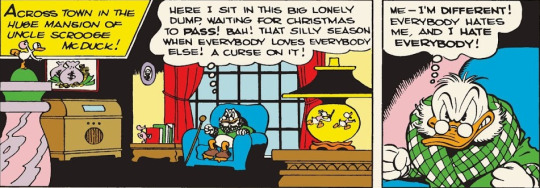
Happy Birthday Uncle Scrooge! Yes it was 73 years ago that everyone’s favorite stingy adventurous billionaire entered this world. And I only NARROWLY missed it as I only found out this was coming up when looking up various character birthdays during the writing of my review of “The Three Cablleros”. I now have a word document with all the various important duck characters birthdays so this doesn’t happen again, but i’m glad I did my homework as I can celebrate one of my faviorite character’s birthdays.
And Scrooge is one of my favorites. While I relate to donald’s everyman slacker spendthrift was a tad more, I still love this old bastard. He’s badass, quick witted, and earned every bit of his fortune square outside of one moment of weakness. But he has his flaws: He’s horribly cheap, quick to anger, and very dismissive and distrustful of people for good reasons and bad. He’s a complicated, interesting character and one that still works today in the reboot.. if with some slight tweaks to make him less of a greedy monster by modern standards. He’s one of my favorite comic book characters, and one of Disney’s finest, so it only felt right to honor him by going back to his roots with his very first appearance and a story that like him is 73 years old today. It’s also one I had never read until today’s review. So does this storied tale still hold up? How diffrent was Scrooge? and are there any actual bears in the story? Well come along with me as we take a trip up to Bear Mountain and find out.
This story, if you didn’t know, is by Disney Legend and Scrooge Creator Carl Barks, easily the most influential and well known duck artist.. felt like it was worth mentioning since without Carl none of this would be possible and as usual his art is gorgeous and unique to him. On with the show.
We open with Donald and the Boys depressed, as Christmas looks to be pretty drab. While the boys are sad they don’t have a winter Cabin like everyone else...

Donald is even more bummed he can’t afford dinner or presents as he mentions this to the boys, being flat broke. It’s also a nice character beat that Donald, despite his usual hedonism.. would be just fine, with his depression coming from the fact he can’t even give his boys a proper Christmas let alone presents. It’s a stark adult fear and something that really hits as I find the money to buy Christmas presents for all my friends and family during my current unemployment, though commissions, have been helping.
But yes i’m doing my first Christmas review before thanksgiving’s even come in. But given the serendipity of Scrooge’s birthday and the fact I wanted to read it at some point before covering the last chapter of life and times anyway, since said story takes place DURING this one. I’ll explain how in a moment. Plus frankly with me already having to do my christmas shopping while I have money, I still feel the spirit of the holiday, so I honestly figure why not.
But all that aside, the Nephews muse things might be better if their rich Uncle Scrooge would remember them, but probably not. We’ll meet scrooge, if you care to continue, after the cut.
We then cut to Scrooge’s mansion. Two things to note. The first is that he has a mansion here. Now for us Ducktales fans, it’s not unusual, he lives in one in both series. But being even MORE frugal in the comics meant after this he mostly lived in the money bin to save .. well money. So he dosen’t have the mansion after this and Don Rosa explained it, as he did really most aspects of scrooge’s life, in life and times, having him decide to sell the place after also deciding to reopen the bin. Just a neat fun fact. The other fun fact is that his angry pose and expersion here were later homage in “Last Crash of the Sunchaser!”, in one of Ducktales 2017′s easily most heart pulling moments: the ending of the episode showing Scrooge truly alone once again. It’s also a nice refrence to Life and Times as at this point scrooge was just as miserable and alone according to Rosa’s masterwork, with the boys and Donald coming into his life being the thing that revitalized him. So let’s get on that shall we?
Scrooge is wallowing in his misery, having never had any fun according to himself and thinking maybe giving a present could be fun.. and decides on his Nephew as the one to give it to. But in typical Scrooge fashion instead of just giving his Grandson a gift, he’s going to have to earn it. He sends a letter to the Boys and Donald offering up his cabin, fully stocked with goodies and presents. A bit pricey for who Scrooge would become, and a bit odd to see him not complain.. but it still sets up his character as someone who wants people to WORK for what they get, but can genuinely get behind someone who shows good character, in this case he’s hoping, but Doubting, Donald will end up showing himself to be brave. And it’s STILL more plausible he’d buy luxury items to prove a point to himself, than it was in that one Ducktales comic I reviewed where he spent presumably millions to teach a ten year old a lesson about getting everything you want. Which yes really happened.

Still not over that one, what the actual hell, let’s move on. Basically if Donald passes the test, he’ll get a real true present and if he doesn’t, well Scrooge will have fun anyway. It is easy to see the difference in character here: While parts that would later become bedrock, his code of honor and his wanting people to EARN things instead of just having them handed to them, as well as him sometimes being a huge dick about that are there, he comes off more as a golden age villain cackling in his lair than the awesome but flawed adventurer we’d all come to know and love. I mean while he’d be no less kind to the Boys and Donald about their poverty later, this time he’s especailly bad tempting them with a nice christmas they couldn’t afford and planning to scare the bejeezus out of them. But I do like seeeing where Scrooge came from, STARTING as a decrepit old bastard and transitioning into the adventurous old bastard we all know and love. I have come to realize I do have a soft spot for characters earlier appearances, seeing what changed, what was there all along, and what was tweaked. It can be a mixed bag: with Marvel for instance sometimes you get Spider-Man, who was starkly anti-social and on the verge of understandably lashing out at the world a LOT in the first few issues, and prone to issues you wouldn’t see in a superhero comic back then. Hulk started out much smarter, greyer and meaner, eventually leading to the Joe Fixit persona being created as a result of this decades later.
On the other hand some examples are less enjoyable like Sue and Reed Richards, who back at the start were a sexist “panicky female” stereotype and a sexist mentally distant jackass, while Hank Pym and Wasp were again, a sexist mentally distant jackass, and another stereotype this time thinking almost entirely about fashion and boys. All four would go on to be MUCH better characters with age, with the occasional slip up. I bring this up because Scrooge... is still a good character even here. While he’d become even BETTER, he’s not bad at all here, just a bit different is all.
Back at the plot Scrooge reveals his plan by scaring the shit out of his butler: To dress up as a bear, head up the mountain and scare his nephews to see if any of them have any bravery. While Donald whimpers over the thought of bears and we get an okay gag of him thinking a squireel was one, Scrooge is forced to turn around due to the weather and gives a villain monologue about never having given anyone nothing in his entire life. I swear to god he’s basically Mr. Burns in this one.
youtube
Then again I would also FULLY expect Scrooge to do this to Donald in the barks stories, just maybe not have it be lethal. MAYBE.
While Scrooge harumphs over his bad luck the boys and Donald enjoy a wonderful sleep. Despite Donald’s fear of bears, which the boys insist are hibernating, accurate, the boys force him to go out and get a Christmas tree by the age old tradition of whining until he does so. After going out back to find a tree to chop down Donald finds dead, ugly looking tree that’s weirdly heavy. To no one’s suprise, and to Donald’s natural luck, there’s a baby bear inside and as Donald gets a nice Christmas eve dinner ready for the boys, though after hearing some rustling he assumes a bear is present.. which it is. A baby bear. Awww. The little guy toddles around, and we get af ew pages of antics, with the boys chasing the bear, donald being a coward, and the bear getting into things and ending up on a rollerskate, which is referenced in life and times. However while the boys eventually find the baby.. it’s MOTHER, angry it’s cub is missing finds them and once Donald finds her, the four naturally hightale it out of there. The bears then eat all their food.. though the boys assume “there goes our presents”. Uh guys.. the presents aren’t gone you just don’t have them right this second. They aren’t showed destroying them or anything just leaning on them slightly. I mean the well stocked pantry and any candy in the presents are toast but there’s still a pretty sweet saxaphone there. Take a look.

See the most their doing is likely wrinkling some clothes, at worst flattening that skateboard.. or whatever that Mama Bear is sitting on. I mean I get in the larger sense they can’t get them because bears, but still. Once they pass out the boys send in Donald to get ripped apart by a bear.. er to tie up Mama Bear so they can get the house back, rightly pointing out that they’ll freeze to death anyways.. even though they you know have a car and could just leave. Then again knowing Donald’s luck i’td probably jsut lead to this.

The boys aren’t slacking though and are going after the cub while Donald passes out in fear next to the bear. Scrooge arrives, but is spooked by the cub and is proud to see his young nephews valiantly chase the bebe, and is impressed by Donald’s seeming bravery, decides, after fleeing in terror which is funny. Not in line with what he’d become but STILL really funny. But anyways he decides to throw them a proper christmas as a reward.
So the next day and, thanks to Don Rosa one part of life and times later, we end on Christmas Day as for the first time in decades, Scrooge basks in the warm glow of family, and is happy probably for the first time in years. He gifts Donald a bear skin, he faints, haw haw haw the end.
FINAL THOUGHTS:
This story holds up extrodinarly well. While some aspects like Scrooge being generous or cowardly don’t jibe with his later character, it’s forgivable since, again, first appearance, and it’s an entertaining story. Granted his plan hasn’t aged well, but it’s still a fun Christmas set story with some good gags and an entertaining villian. While not Scrooge or Donald or Barks finest hour, it’s still a good bit of hollday fun that gave us one of the best characters of all time. And for that, ill be forever greatful.
If you liked this review, you can comission one of your own via my ask box, direct message or discord (technicolormuk#6550), if your more comfortable not doing buisness on here.
UPCOMING REVIEWS TO KEEP AN EYE ON THIS SPACE FOR
Loud House Coverage: Band Together/ The Other One
Ducktales: The First Adventure!
Ride of the Three Cablleros: The Three Cablleros Ride Again!
Until then you can check my backlog on my various pages and remember, there’s always another rainbow.
#ducktales#scrooge mcduck#christmas on bear mountain#carl barks#donald duck#huey duck#louie duck#dewey duck#christmas#comics#reviews
17 notes
·
View notes
Text
Best of Marvel: Week of February 19th, 2020
Best of this Week: Fantastic Four #19 (Legacy #664) - Dan Slott, Sean Izaakse, Marcio Menyz, Erick Arciniega and Joe Caramagna

It all began with one fateful foray into space.
Reed Richards, a gifted scientist from Empire State University, his brilliant wife, Susan Storm, her hot headed younger brother, Johnny Storm and expert pilot Ben Grimm board the Marvel-1 in an attempt to explore space. Unfortunately for them, their ship is hit with a wave of Cosmic Rays, sending them crashing back to the Earth and giving them all special powers. For decades, we all thought that everything was Reed’s fault for not having strong enough shields, blessing and cursing his family with powers, but we learn here that that is not the case.
Throughout the last five issues, The Fantastic Four have been fighting against the people of Spyre; A planet of normal people, enhanced people and monsters that have feared the prophecy of the “Four-Told,” beings that would destroy Spyre and their way of life. After Reed exposes their leader, The Overseer, for being the one that released the cosmic rays on the Four, Ben climbs his tower, beats the everloving crap out of him and destroys the tower in the process.
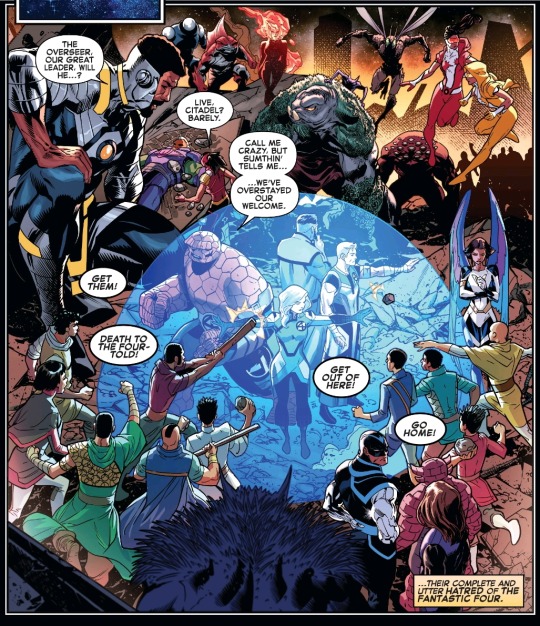
Realizing that the Overseer stands defeated and the eye that watched them is no more, every citizen turns on the FF, proclaiming that the prophecy did happen as the Overseer lay in the rubble. This issue picks up in the immediate aftermath (after a preview of the coming story in the first few pages involving Mole Man and Wyatt Wingfoot). Sue places a barrier over the FF as the citizens, heroes and monsters pelt her forcefield with fists and rock. Previously, the citizens were divided by their classes, but now they’ve united against Reed and the Four.
One of the more interesting subplots that Dan Slott had been weaving is the burgeoning relationship between supposed “soulmates” in Johnny Storm and a Spyrian hero named Sky, a darker skinned girl with wings that may actually be in love with another hero by the name of Citadel. This is one of the few times that Johnny shows an actual longstanding interest in a woman, especially since their connection was made shortly after the Fours first failed mission unbeknownst to him.
Slott had been building this up and getting readers invested in their struggle of love and it’s good to see Johnny loving someone like he did with Medusa or Crystal of the Inhumans.This is further tested as Sky is torn between the traditions of her people and her disdain for the FF after their actions. Of course, she’s not the only one who is irate as the Overseer picks himself back up and calls Reed out for a one-on-one brawl.

Reed’s never been the best fighter in the world, but he’s always had ways to use his powers to his advantage and can still hold himself pretty well. Sean Izaakse portrays that pretty well with a few expertly drawn pages of battle as Reed uses his stretchy abilities to dodge energy beams, punch Overseer from afar and uses his arm as a slingshot to fling boulders at the villain. Izaakse and Erick Arciniega work in perfect tandem to make these scenes exciting with bright colors and dynamic angles.
Things get even crazier as Overseer fights back with his own arsenal of suit abilities. Izaakse draws amazing looking rings for sonic blasts that Arciniega colors with a beautiful yellow. Then switches it up for crackling blue lightning and finally ends things with Kirby-esque bubbles of energy that go from a dark orange to a dastardly purple to match Overseer’s beautiful armor. This fight is absolutely gorgeous to look at even as the panels are mostly medium sized, widescreen rectangles.
Throughout their fight, the two have an exchange that boils down to hubris vs. personal responsibility and both make pretty good points. Reed had always blamed himself for what had happened to his friends and family, thinking that his miscalculations are what put them all in anger and that weight is lifted off of his shoulders with rage at finally punching the cause. Overseer, feared for the lives of his people from the potential threat from beyond by a man that never asked what the greater galaxy wanted. Reed always does things like this and Overseer’s only course of action was to curtail it before things got bad.

As always, Reed does what he does best, uses his brain to talk Overseer down, knowing that he too hasn’t fully mastered the use of Cosmic Rays and suggests that they could accomplish more together than against each other (opposite his conversation with Charles Xavier - see X-Men/Fantastic Four). Reed proposes that the two make a trade of sorts and offers the people of Spyre a chance similar to what Ben has in “The Almost Cure,” something we’ve seen used recently when Ben and Alicia Masters went on their honeymoon and would have allowed him to turn human for a day until he fought the Hulk and landed in a coma.
The Monster Men take umbrage with the idea because Ben had preached appreciating who one is on the inside when he rallied them to fight Overseer, but when one of the Heroes of the Spyre asks if it will work on him too, almost everyone seems to want in on the change. Of course there are others who see the FF’s gift as what will truly destroy their people, showing that some people just can’t be pleased. As their time on Spyre draw to a close, Reed and Johnny bond together like they did when this arc started as Johnny muses on what his life would have been without his powers.
It’s a touching scene and Dan Slott has always been great at things like these. From his time on Spider-Man and She Hulk, he’s shown that he has skill in giving readers heartfelt moments, especially given that we almost hardly ever see the pair together. This is accentuated by Izaakse drawing Johnny with a smile on his face as he flies through the skies with an almost old school look colored by Arciniega with lush oranges and intense reds.

Just as the FF are about to depart, Overseer tells them that only ones soulmate can remove the soul bindings on their arms. After a few pages of searching for Sky, she shows up to Johnny. I think the implication is that she went on some soul searching away from Johnny and when he offers to remove her Soul Binding, she refuses and tells Johnny he can keep his too as she’s joining them on the trip to Earth.
Suffice to say, this is as shocking to The FF as one might expect as they add yet another hero to the ranks, but she likely won’t be on the main team, but more as a supporting role until Marvel decides to give her a miniseries and then sends her back to the Spyre. She’s certainly a welcome addition and it’ll be fun to see what kind of shenanigans she and Johnny will get into as he’s naturally flirtatious and she wants to keep to the traditions of her people. It’s difficult to say that she’s fully in love with Johnny still as she flirts with Citadel before they disembark.
Overall, this was a really fun issue and concludes a story that had a surprising amount of heart and depth. Generally, I like the idea of Cosmic Happenstance and did love the mysterious nature of how the FF got their powers. I might have preferred that things be kept random chance, but honestly, I wasn’t put off by this equally ridiculous explanation either. At the same time, Dan Slott also alleviates some of the guilt from Reed’s shoulders which could be a double edged sword for him in the future if his ego grows too large.

Sean Izaakse and Erick Arciniega also do an amazing job on the art (I can’t leave out Marcio Menyz, but I didn’t really care for the Wingfoot stuff). The pair smash it with the visual storytelling through fantastic facial expressions, body language and utopian setting. One thing that took me time to notice was that all of the people of Spyre were black. It’s a small, but nice touch that makes them stand out amongst the other races that we see throughout the galaxy.
Depending on how the next issue goes, I may stick with the series, but I’ve never been a big fan of Mole Man stories, so I may drop off until the next arc, but this one was absolutely worth the time, a high recommend!
Also, support me on Patreon:
patreon.com/TyTalksComics
#fantastic four#reed richards#sue storm#ben grimm#johnny storm#dan slott#sean izaakse#erick arciniega#joe caramagna#cosmic marvel#marvel comics#comic review
8 notes
·
View notes
Text
Spider-Man Self-Improvement #1 Thoughts
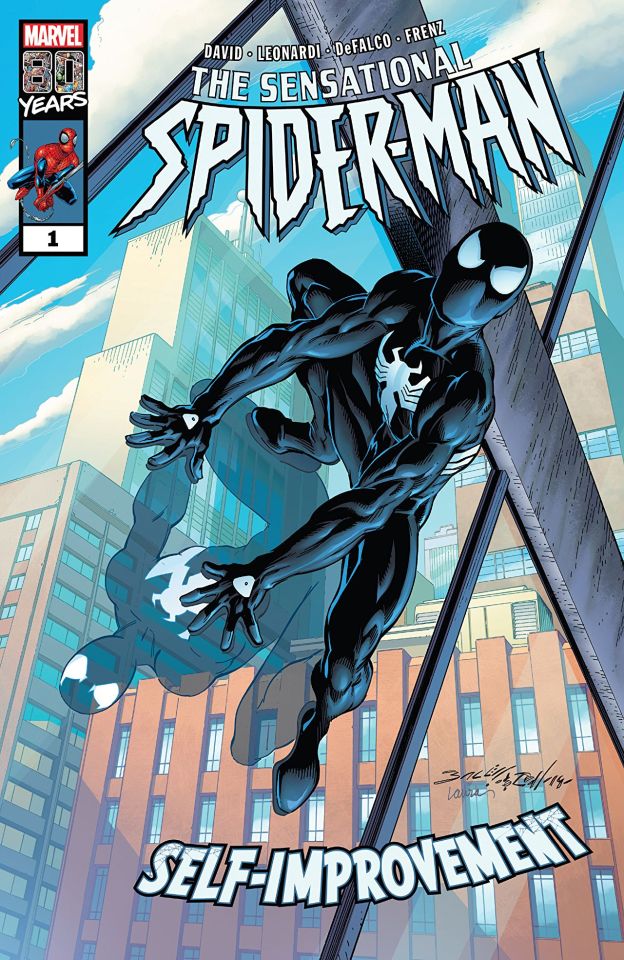
A historic moment in Spider-History!
I’m sure you all know the backstory to this issue if you are reading this, but just in case you don’t I’ll briefly explain.
Once upon a time in the 1980s Marvel fan Randy Schueller proposed an idea about Spider-Man getting a new black costume from Reed Richards with all sorts of special features. Marvel liked the idea enough to buy it and bring the fan in to work on the story behind it. The original story ideas were never used but were later repurposed for what eventually became Spider-Man’s iconic black costume, which later of course was revealed to be an alien symbiote and later still became fan favourite villain Venom.
Spider-Man Self-Improvement is a comic book based upon Schueller’s original vision for the costume and the story surrounding it, but brought to life by writer Peter David and artist Rick Leonardi, coincidentally the co-creators of Spider-Man 2099.
Schueller’s original vision for the costume was that it was a high tech outfit created for Spider-Man by Reed Rchards. The design of the costume would ostensibly be identical to the black costume we all know and love, albeit with the white parts swapped for red. It would be made of unstable molecules (see the Marvel wiki for more info on what those do) that would improve Spider-Man’s wall-crawling powers and come with cybernetic components that would enable his to mentally control his webshooters. There are at least two drafts of Schueller’s original story that we know of, and an element in both of them is that the black costume is somewhat frightening to people and that Peter ends the story opting to not make the costume his regular attire. There are other elements to the story but we’ll talk about those later.
All the above elements are what made it into PAD’s version in this comic.
As a story unto itself it’s fairly superfluous. It’s really not worth the price of a standard issue of ASM, but perhaps wouldn’t have been as objectionable if it had been priced at early-mid 1980s prices (which even accounting for inflation were a lot cheaper than today).
There is nothing egregiously wrong with the story itself, it’s just very simple, basic and linear is all. As Spider-Man stories go at worst it’s subpar because it doesn’t address his personal life all that much beyond the very last page where he pricks his finger sewing his old suit back together; and I guess the fact that he can’t control his webbing.
The most interesting aspect of the story to me, beyond the superficial coolness of seeing the original black costume, was the idea that the costume would be scary and intimidating and thus prompting Peter to reject it in favour of his classic friendlier attire.
It’s a small but interesting angle to take with the character and feels I dunno...appropriate for Spider-Man’s character. It also touches upon a topic I talked about a long time ago regarding the black costume vs. the classic costume.
In that post I referenced a fan letter published shortly after ASM #300 where a fan talked about why the classic costume was much more fitting for Peter’s character. This issue by accident or design seems to subtly echo some of those sentiments. It is ironic though given how Peter David’s work on Spider-Man famously featured him in his black costume and used it to tell darker and grittier stories. Then when David and Leonardi went on to create Spider-Man 2099, who was also edgier than the classic version, they intended his outfit to also be red and black like this version of the costume. And of course now days PAD is working on symbiote Spider-Man, which is possibly what led to him getting the assignment for this issue.
I hesitate to really critique PAD for this because he is after all simply executing someone else’s story, and the story was really more of an under developed outline. It was a few ideas strung together and little more than that.
The design of the costume is cool, and having Rick Leonardi, which IIRC had some kind of contribution to the look of the original black suit, draw it was a cool touch, referential to history too.
His art in the story is also mostly fine. I say mostly because weirdly everyone looks fine except for Spider-Man himself. In either of his outfits in this comic he seems a tad...off. I can’t quite put my finger on it, but he just doesn’t look right and seems oddly out of place next to everyone else. To say it’s not the prime of Leonardi’s art like in the 80s or the 90s would be an understatement but it is not bad by any means.
More interesting than examining this issue unto itself though is the opportunity to play compare and contrast with both Schueller’s original drafts and the original Alien Costume Saga. That could get a little long but let’s try those out in brief.
Schueller’s drafts are actually included in this issue as a very fascinating piece of Marvel history. In addition to what I talked about above, you have Sue Storm and Janet van Dyne designing the look o the outfit in the first draft, Spidey being over excited like a kid with a new toy in both drafts, him having the equivalent of gliding web wings or a web cape in one of the drafts, his inability to control the webbing in both drafts and the idea that the cybernetics interfere with his spider sense, which is more pronounced in the second draft.
I think PAD cut these elements out to better streamline the story, and the Wasp making Spider-Man a new costume doesn’t jive very well with their established hostile relationship.
Firebrand’s inclusion in PAD’s version instead of generic thugs is likely to add something more visually dynamic to the story, something that would better test out the suit’s new abilities given how fighting regular thugs is something he could do in his regular outfit.
He retained the idea of Spider-Man having to rescue a woman though, just in Schueller’s original draft but changed her fate and circumstances; her situation reminded me of his Five Minutes prose story from Ultimate Spider-Man actually. In Schueller’s original draft the injured woman Spidey failed to save felt rather out of left field, something oddly dark and cruel to pop up in a story which up until then had been a lighthearted tale about a kid and his new toy. It also set up the idea of him becoming a darker avenging figure in line with the suit’s scary new look. Which was ahead of it’s time now I think about it.
The first draft I feel suffers from something I see a lot in fanfiction. I won’t rake fanfiction over the coals here because being wacky, experimental and well something you wouldn’t normally see in professional works is part of it’s charm. However Schueller’s script wants to use the lore of the established universe badly and use it to introduce something they’ve dreamed up themselves. That’s fine and dandy but often I’ve observed that this comes off as contrived in many fanfics and sure enough that is true here. Why would Reed Richards for instance whip up a new suit for Peter? In the PAD version of the story it’s still a little eyebrow raising but he essentially did Spidey a kindness after he almost died of burn injuries. In Schueller’s draft Wasp and Reed just decide to give him a gift out of the blue. Schueller better justifies this in his second draft but DeFalco still scrutinizes the decision.
I also think Schueller in both drafts sort of lost sight of the core idea behind Spider-Man, moreso in the first draft. He was clearly enchanted with the idea of Spider-Man having a high tech suit with cool features that he didn’t stop to consider if that really fit well for Spider-Man’s character. Credit where credit is due he did come to a compromise in his second draft wherein Peter would keep the suit but use it sparingly as a treat for himself. However I found the rationale behind that rather contrived. Schueller in fairness was trying a lot harder in that second draft and it was markedly better, but pretty much all of DeFalco’s critiques were on the money. Would Spider-Man really be like a kid with a new toy? Would he really care that much about his public reputation? Would the Bugle really not want pictures of this other superhero?
By the way, this is a total dick move on my part I admit, but seeing DeFalco shoot down Schueller’s script was I’m sorry to say kind of funny to me.
Overall PAD made much better use of Schueller’s drafts, he knew what to drop and what to keep and how to rearrange the pieces to make it all work much better.
More significantly I think is the fact that Schueller might’ve had more influence from his drafts than even he imagined. Some of his ideas are rather reminiscent of Spider-Man 2099 and the Iron Spider costume. Could it be that the creators of both were directly or subconsciously influenced by his original drafts? Or was it minds thinking alike? I prefer to think it was the former.
Comparing all 3 versions of this original story to what we got in the Alien Costume Saga I have to be blunt, the original is simply much better.
Making the costume an alien allowed for a more dramatic rationale to get rid of the suit and more importantly taps into the Parker luck. Rather than the costume being a cool new toy which has some kinks ad drawbacks which makes Peter drop it or drop it but keep it as a treat for himself, DeFalco and Frenz made the suit too good to be true. The Parker Luck in action!
The features of the Alien costume were also more impressive than those of Schueller’s, and they repurposed the way it interfered with his spider sense in a more interesting way. Rather than opening him up to possible dangers the suit itself WAS the danger because it didn’t trigger the spider sense.
So, whilst this issue is a fun ‘what could have been’ story, I think ultimately we were lucky to get what we got.
All that might sound like I wouldn’t recommend you pick this up but it’s quite the opposite, I think this is worth your time. Check it out.
#Spider-Man#Symbiote Spider-Man#Venom Symbiote#Alien costume saga#Tom DeFalco#Peter David#Peter Parker#Reed Richards#Mr. Fantastic#Mister Fantastic#the wasp#wasp#janet van dyne#Rick Leonardi
22 notes
·
View notes
Text
Reaching out across Tumblr to all my G&S fans, @carpe-mamilia and I just got back from Harrogate from this year’s G&S Festival, and I have some thoughts about the shows which I think I just needed to get down.
Also, bonus shoutout to @carlodivarga-s for being an all-round charming presence and delightful surprise in Harrogate this year!
OK. Here goes.
Princess Ida (Savoynet)
As Stephen Turnbull (he of Harrogate ramblings on Facebook) mentioned, this is a production that could have only worked at the festival. With the two kings portrayed as Gilbert and Sullivan themselves, and the rest of the company (with the exception of Ida herself) costumed as choruses from the rest of the G&S universe.
I know that Ida is written in 3 acts, but to have two 15 minute intervals is a strange experience. Especially as the curtain came down on the Act I at 8:15, it felt as though we were only about getting started and we were all back out our seats and into the bar. When I saw Ida done in Southampton earlier this year, they split Act II in half and placed a single interval more squarely in the middle, and I didn’t think that the pacing or structure suffered as much as it perhaps could have done then.
My greatest issue with Ida is that.. it’s not a very interesting story? And certainly not a very good ending. It feels as though Sullivan far outshines Gilbert. Some of the plot points, too, feel very, well, seen-before? Most noticeably, the male trio dressing up in silly costumes and singing witty songs about it? Done in Patience (and much better, I should add!). That said, Ida definitely has some standout solos, in particular Gama’s two patter songs (’I’m such a disagreeable man’ and ‘Nothing whatever to grumble at’), and Death to the Invaders! is such a TUNE at the top of Act III, though I actually preferred it in Southampton, just as there was more drama and sense of impending peril.
The ending of the whole thing is pretty crap though. Here’s Ida, a feminist ICON who shuns men and rules a chorus of strong academic ambitious women who look down on men, and yet she sort of just limps across the finish line like, oh yeah, I guess I’ll just love you and marry a man and I was wrong about all my studies and thoughts of independence. Ugh.
Y’know what I want to happen to Ida? I want her to shun all the men and grow old, independent, and married to a woman. Princess Ida: a queer legend.
Trial by Jury & The Zoo (LOpSoc)
I can’t say too much about the productions because it was my old university group and I’m sure I can’t write without any bias, so I’ll focus on the shows.
Trial by Jury was my first real show as Musical Director so it’ll always have a spot in my heart, especially having studied law at university. Musically, it’s so well accomplished, at barely 30 minutes, Sullivan manages to cram in so much content, including the brilliant ‘A Nice Dilemma’ sextet (or septet if you count the chorus as one, too), as well as some beautiful patter songs and some great parts for the chorus. You can really see how the rest of the Savoy Operas took inspiration, and to a certain extent, structure, from this first piece.
That said, there are a few familiar elements missing from the piece that become G&S standards later on in the canon, including the contralto exposition song, the romantic leads’ duet, and, well, a second act. Still though, one of my favourites.
The Zoo on the other hand? I’ve now seen it three times, and whilst I enjoy the music, some of it really is quite good, I have no idea what actually happens. I think there are at least 3 plots intertwined with one another, but with no libretto to explore or explain those plots, it’s essentially three totally different stories happening at the same time, just... coincidentally at a zoo. Libretto is pretty naff, but there are some charming songs, such as the ‘Four Tarts and a Couple of Pairs’ jaunt, and the duel of the male and female chorus once the Duke has eaten and faints (??) (’Prop him up upon a chair, lay him flat upon his back’).
Good news though, that LOpSoc were nominated for best director and best chorus for this production which I thought was well deserved.
Ruddigore (Charles Court Opera)
Oh my word. I confess I’ve never been Ruddigore’s biggest fan, but boy oh boy am I a fan of Charles Court Opera, so the chance to get to see this production was high up the list, and it certainly didn’t disappoint. With a cast of 9 (and totally omitting the male chorus), this production was lively, sharp-witted, and for the first time in any production of Ruddigore that I’ve seen, or indeed been involved with, I followed every detail of the plot perfectly.
Only two bridesmaids made up the female chorus, and they also lent their voices to a mixed chorus for the ‘Painted Emblems of a Race’ and subsequent male-chorus numbers (though ‘Welcome Gentry’ was cut) which worked beautifully. Also, a nice little change to Mounted emblems of a race, as the three ancestors were portrayed as severed, mounted heads on the wall of the set. Sir Roderic did have an additional stage presence as he was also portrayed by the accompanying headless corpse come to life.
One of the absolute highlights of this production, too, was lovely, wonderful Simon Butteriss, who is always an absolute joy. With John Reed-esque lightness, but with a voice on form as ever, it was a joy to see him on stage. As it was the whole cast, really. Having seen CCO’s HMS Pinafore at the King’s Head in London in a tiny 100-odd seat fringe theatre with just a pianist, to see them on stage at the Royal Hall in Harrogate with a complete orchestra was really special.
Yeomen of the Guard (National Gilbert and Sullivan Opera Company)
Oh boy. I was so excited for this performance. And I was so disappointed. The victim perhaps of a festival matinee crowd, as I said to dear friends over dinner after the show, there are a certain number of ‘minimum requirements’ I expect of the NGSOC:
The cast remember their lines. Having a certain member of the principal cast prompted from the wings was... well. Awkward to say the least. And garnered the intake of breath you can imagine from the audience.
I expect the principal cast to be able to stick to time with the orchestra. Several times, the cast fell wildly out of time with the orchestra, making for highly awkward listening.
I expect the principal cast to be able to hit all the notes they’re expected to. Naming no names, but, with a certain soprano aria in Yeomen, there’s a rather important note towards the end that you cannot get wrong. And yet.
I expect the show to be lit well. If actors are stood singing in darkness, either the actor needs to find their light, or the lighting director needs to do a better job.
That all said, the chorus were fantastic, to the point I actually longed for them to come back on to stage whenever they were gone, but I must say of Andrew Nicklin’s direction... I found it lacking. The staging was particularly dull and unimaginative, with barely any choreography, or even any movement come to that. My first time actually seeing Yeomen on stage and... ugh. Y’know? That said, there were reports from a friend having seen it earlier in the week at the festival and it being remarkable, so.. maybe just an off-performance.
The Mikado (National Gilbert and Sullivan Opera Company)
Now, THIS is how you do G&S. The company were almost unrecognisable from the afternoon, and the show was packed to the rafters with joy, energy, and sheer brilliance. Genuine laugh out loud moments from a full auditorium who are, I’m sure, more than familiar with the source material! Andrew Nicklin who was conducting, made sure that the pace was kept up, and my word, just, my heart was pounding with, well, a combination of relief and amazement. I loved it.
In particular, Mae Heydorn as Katisha. Fuckkkkkk. This wasn’t your usual Katisha, this was a dazzling, glamorous Katisha, and although you’d think that might not work, it did. And what a voice. On the final note of Act I, Mae managed to outsing the full assembled company and orchestra with a note that travelled and reverberated into our very bones.
My only criticism would probably be that Richard Gauntlett, who also directed the show, delivered some of Ko Ko’s lines so fast, if you weren’t familiar with the show, you wouldn’t have a clue what he’d just said. That and Nanki-Poo, in a typical tenor manner, did tend to rush some of the songs, even when singing as part of a trio - perhaps a little indicative of not listening to his cast-mates. But alas.
____
OK, I think that’s all. A brilliant, lovely few days away. So much G&S. I loved it. So much so, I think I’m going to start a bit of an artistic project to create some more G&S content, so keep an eye if you’re interested!
-- Thomas
16 notes
·
View notes
Photo
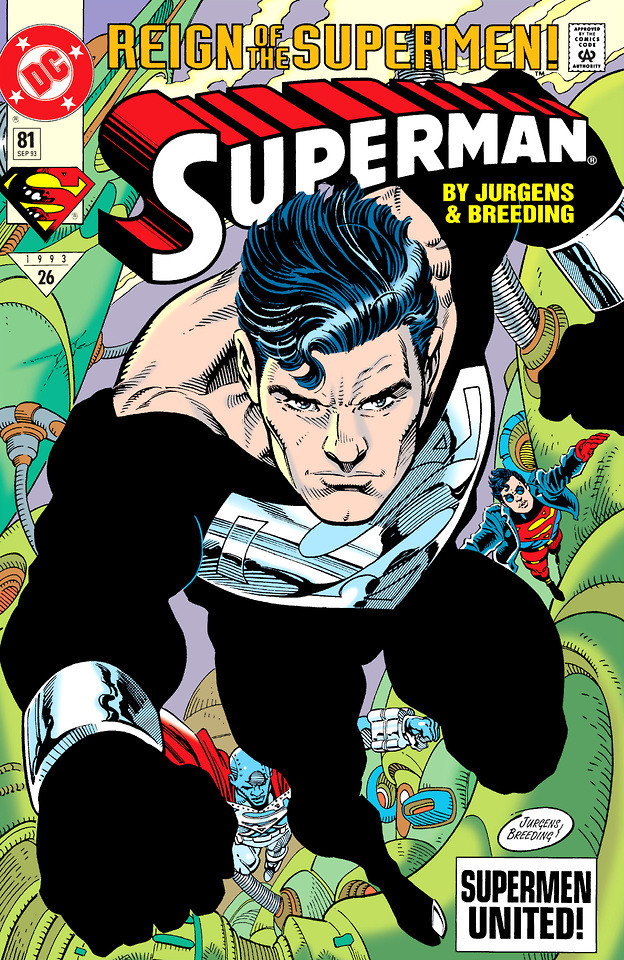
Superman #81 (September 1993)
REIGN OF THE SUPERMEN! The secret origin of the Cyborg Superman! We find out that the genocidal robot guy posing as the dearly departed Supes is actually someone we've seen before -- a seemingly minor threat from the past, supposedly lost in the vastness of space. That's right, the Cyborg is in reality... freaking Psi-Phon and Dreadnaught.
No, not really. The Cyborg is none other than astronaut Hank Henshaw, the Reed Richards analogue from that "Fantastic Four, but they all die horribly" story in Adventures #466.
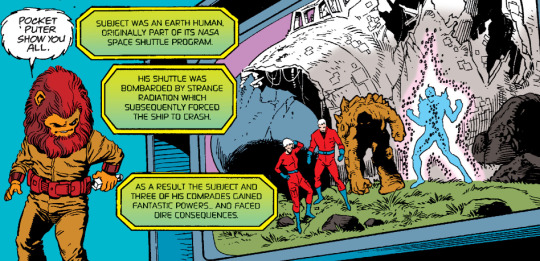
Two months after that, in Adventures #468, we found out that Hank's mind had survived by jumping into a LexCorp computer after his irradiated body fell apart. Hank builds himself a dorky new robot body, but unfortunately, his wife couldn't handle seeing him in that state and went catatonic... and died, too, apparently? Or at least Hank and his minions seem to think so. At this point, Hank decided to jump into Superman’s Kryptonian baby rocket and leave the Earth because his powers were messing with our satellites, and also to avoid being sued by the creators of Johnny-5.
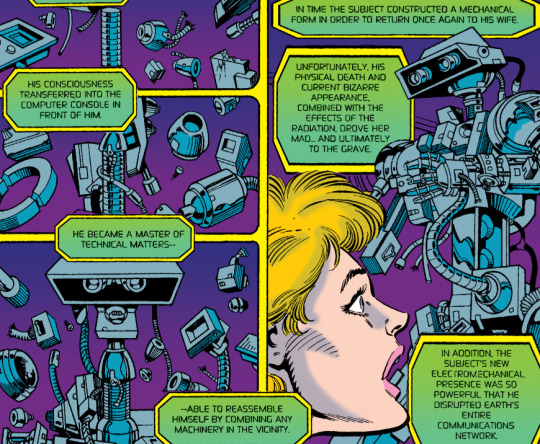

Anyway, Hank traveled the universe for a while until he bumped into the little backwater planet currently ruled by Mongul, former leader of Warworld (last seen running away all the way back in Adventures #455). Hank basically zapped Mongul until the big yellow oaf agreed to become his lackey on his quest to get revenge on Superman for supposedly failing to save his fantastic friends. Upon finding out Superman was dead, however, Hank came up with another plan: using the DNA from the Kryptonian baby rocket to make himself a new body that looks like Superman and nuking the Earth's cities to ruin his good name.

Meanwhile, in Metropolis, the mysterious long-haired Superman in the black suit is having trouble convincing Lois, Lex Luthor Jr., Steel and Superboy that he's the real deal. For starters, he doesn't even have any powers. Lois looks more convinced after she and man in black share a (pretty familiar looking) kiss, but he can't use that same tactic on all the others. Eventually, he gets tired of all the arguing, grabs some flying boots from one of Lex's armored bodyguards, and says he's just gonna go stop the Cyborg and the others can join him if they want to. Superboy and Steel are like, "ugh, FINE, we'll go too." CONTINUED!
Character-Watch:
I’d be really interested in seeing a story about how, exactly, Hank started hating Superman. He still seemed pretty sane at the end of his last appearance, and left willingly to avoid interfering with the Earth’s communication systems. I guess the vastness of space drove him mad, but I’d still like to see his evolution from Sadder Reed Richards to Crazier Doctor Doom. My personal theory is that being inside LexCorp’s computers had something to do with it. Maybe some remnants from Brainiac’s mind (remember he also lived inside LexCorp at one point) combined with seeing Luthor’s secret porn stash drove Hank insane.
Also, we never actually saw his wife’s death (how did Hank find out about it, anyway?) and every comic book reader knows that if it didn’t happen on panel, it didn’t happen. So, I think another interesting Cyborg story would be Hank finding out she’s still alive, but her death is such a central part of his delusion that he refuses to believe it and maybe ends up killing her. (Call me, DC! I have a really good artist friend.)
Plotline-Watch:
Hank’s story is being told by two of his alien minions, a guy who looks like a lion crossed with an Ewok and a guy whose gonads are apparently hanging from his face, all 12 of them. Spin-off series, please.

There’s a brief update on the Eradicator’s state: he’s “healing well” at the Fortress of Solitude, but the Fortress robots are worried that he’ll be sad he missed Kal-El’s return in Metropolis.
The man in black references various moments from the Lois/Clark relationship to try to convince her that he’s telling the truth, like when they got engaged, when he came out as Superman, that time they had their little mountain talk, and, uh... something else. Don Sparrow wonders: “That rainy night in July when we first WHAT Clark? It wasn’t raining the night they first kissed. Hmmmmmm.” It was raining... Jose Delgado’s tears. (Also, funny that it was the “Fantastic Four” issue.)
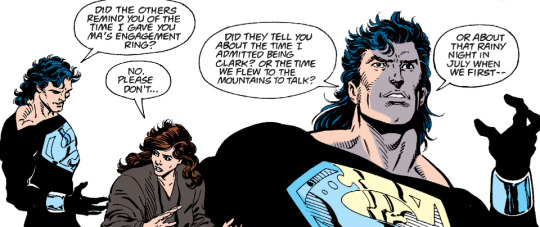
Lois’ reluctance to believe that the man in black is Superman is understandable given that, as she points out, she’s gone through this four times already. The first thing that gets her to listen to him is when he says “To Kill a Mockingbird” -- which, as we learned in Superman #67, was Clark’s favorite movie. And then there’s the kiss, which is a hairier remake of the kiss they shared before he died in Superman #75.

How come Supergirl doesn’t join the Team Superman on their mission to stop the Cyborg? Because Lex Jr. didn’t give her permission, while calling her “my pet”. I’m starting to think their relationship isn’t that healthy.
Dan Jurgens is clearly a fan of Dave Gibbons’ take on Mongul in Alan Moore’s For the Man Who Has Everything...

...but the art department is Don Sparrow’s turf, so I’ll let just him talk about that and other stuff I missed in his section, after the jump!
Art-Watch (by @donsparrow):
I love this issue. Starting with the cover, which lets us know in no uncertain terms that they’re no longer playing around—big things are happening. Besides being a great drawing, I love the relative silence of the image, and how it plays. When you see it, you just have to open it to find out what’s really going on, and whether the man himself might really be back. It’s such a good cover, that I can forgive it for the sleight of hand with the Tarzan hair, which for some reason they have been hiding in recent issues. [Max: I still think they had no idea he’d have long hair when they made these covers.]
Inside we’re greeted with another great splash (honestly, we’re in the peak era of the Jurgens and Breeding team here, as the next few issues of Superman are every bit as good as the Death storyline, visually, so it was hard for me not to scan every darn page!) and I love the different facial expressions here, with Lex and Lois having expressions of disbelief (though that disbelief is clearly motivated differently between the characters) to the determination and spunk of the Metropolis Kid to the cool authoritative detachment of the Man of Steel at the back.
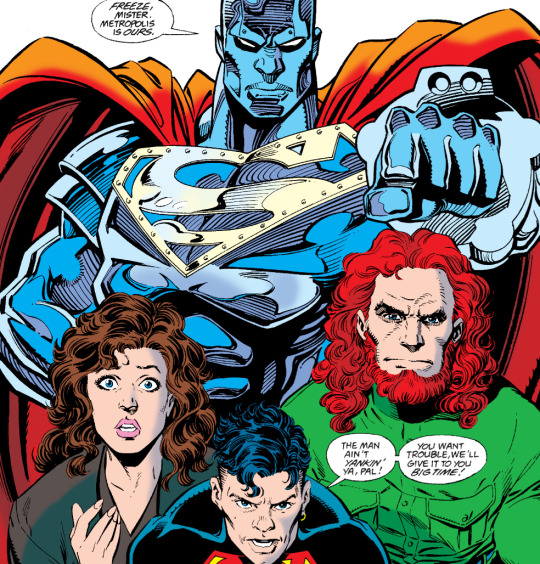
More great body language on the next two page splash, as—to me-- Jurgens and Breeding convey, just with a pose, that the real Kal-El has returned. Though we’ll learn he’s mostly depowered (thanks to the Eradicator using Kal-El’s regeneration matrix as his own energy piggy-bank) he still holds himself with the confidence and invulnerability we expect from Superman. Am I reading too much into a single panel? Almost certainly. But man, this looks great.
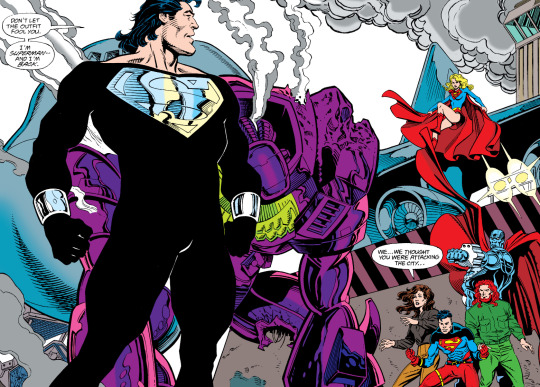
There’s also some great character work from Lois throughout, and they draw her conflicted facial expressions really well, as she just can’t allow herself to hope that this really is what it appears to be—the love of her life, returned to her. I’m sure the Eradicator wearing his face for all these months can’t have helped either.
As we cut back to Engine City, we get another view of how amazingly this art team draws tech, followed immediately by possibly the most painful thing the Cyborg does in these pages—full force heat vision to Mongul’s junk. Ouch. Ok, maybe that’s not as bad as blowing up a whole city, or annihilating a handful of survivors, but still. [Max: He annihilated millions of Mongul’s future children.]
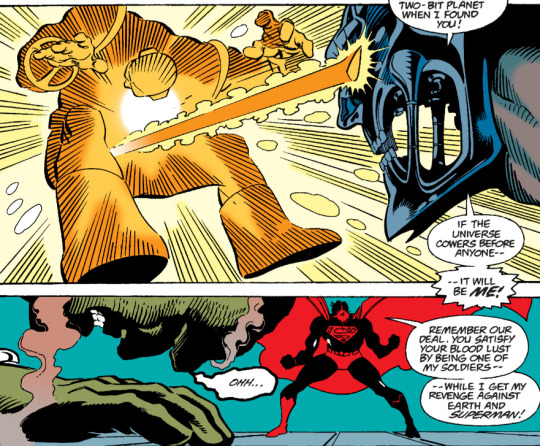
The flashback to the Cyborg Superman’s origins is cleverly delivered, thanks to the alien mercenary’s “pocket ‘puter”. The image of Henshaw reassembling himself (apparently into Johnny 5) is particularly well drawn, and deeply unnerving. There’s also a great image of the bored dissatisfied Mongul on the throne. I wonder if the alien he’s telling the story to minds his conquered planet being referred to as “simple” though.

As with the Engine City pages, Jurgens and Breeding excel at drawing technology, so the freaky dragon creature Henshaw into which converts Mongul’s ship is a great piece of art. The full page splash with Cyborg Superman in his current form is one of the better images of the character as well.
The heart of this issue, though, is the slow change in Lois, who has held on for so long without Clark by being tough. As Superman speaks to her about their life together, she is finally able to melt. As with earlier in the book, the emotions on her face are so well done in this transition.

I love the callback of their kiss, and how it mirrors the tender moment from Superman #75. And, in a storytelling device that they’d use again on shows like Smallville, it is the familiarity of his kiss that convinces her that it really is her fiancé. Goosebumps, man! This is beautiful, romantic stuff. And in true Superman fashion, he just can’t stand around and celebrate the reunion—there’s a job to do, and it falls to him to do it. More goosebumps.
STRAY OBSERVATIONS
A recurring thing in these pages is the artists playing fast and loose with just how tall Steel is. Sure, he’s got the platform jet boots, but at times he is depicted as gigantic as his silver-screen counterpart, and other times he seems roughly as tall as anyone else. This issue veers into the gigantic.

I’m glad he’s back in any form, but it is a bit tough to see Superman wincing at being squeezed on the shoulder by Steel.
Yeesh, we get it, Henshaw’s team were supposed to be analogues for the Fantastic Four, you can stop using the word “fantastic” to remind us. The other hints at it were plenty.
Funny that even that long ago, a handheld computer was the stuff of science fiction, while today, you might be reading this on a “pocket computer” smaller and more powerful than the one the alien holds. [Max: And whilst sitting on the toilet.]
While it’s not the focus of the panel, when the Cyborg “forms the shape of a man” he sure looks a heck of a lot like the Ed Hannigan design of Brainiac from the 80s.

I love that Jurgens, knowing he’s picked up a lot of new readers with this storyline, makes it ULTRA easy to follow, even having the narrating alien say, “still not understand?” before recapping the recap from the previous pages.
I dig the slow burn on Lex Luthor II, and that his villainous nature is creeping out more and more. When he calls Supergirl his “pet”, it doesn’t sound affectionate, but literal here. [Max: Hey, when did Superboy get that Soder Cola? Does a soda vendor follow him around, like Homer Simpson and the hot dogs guy?]

I will never tire of Superboy’s “cool” 1990s speak. Rather than read it as a middle aged writer trying to use hip lingo, it could be read as Superboy being “raised” by pop culture. Because he was rapidly aged, maybe his entire knowledge of the world was programmed by others, who were guessing at how a young person speaks? So he’s not trying to be cool—it’s literally all he knows. But what I still don’t understand is where Robin came from!
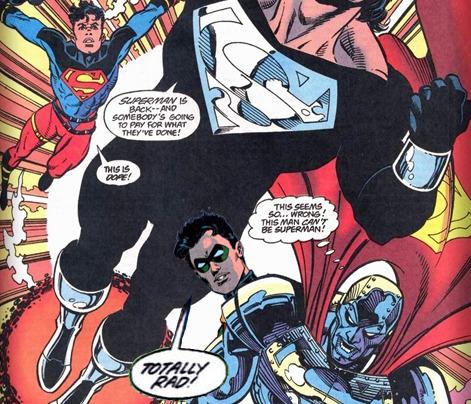
Reading this issue for the first time, I still (mistakenly) worried that the man in black wasn’t the real Superman. This was both because the Eradicator, in his healing bath, has Superman hair (even though we saw his hair get blown off last issue) and because I misunderstood the Kryptonian robot’s line of dialogue about ‘the master wanting to be there when Kal-El arose’. Though this is actually a confirmation that Kal-El has indeed arisen, I thought it meant that the guy in the bath was the real Kal-El. Plus, Steel has been the character the most “right” and in-tune with the spirit of Superman, and throughout this issue, he’s very dubious of the man in black being the real Superman, even saying how it seems to wrong. Which I read as a hint that maybe there was another twist coming.
#superman#dan jurgens#brett breeding#steel#superboy#Awesome Kryptonian Battle Robot#hank henshaw#mongul#fantastic four#eradicator#kelex#lil lion guy and gonad face#reign of the supermen
22 notes
·
View notes
Text
Leo Fender, Les Paul and the Birth of the Solid-Body Electric Guitar Industry

Interesting timing on a number of fronts...chiefly being that a book about this very subject is being released shortly.
Over the past few weeks, I’ve really dove into all the various design details that Leo Fender engineered in the 1950′s, and my favorite parts have been talking about the designs in a historical context. Design features like the foam mute on the P-Bass “ashtray” that helped combat issues with primitive amplification.
And while I’ve alluded to things like “there not being third party parts manufacturers at the time,” I never really touched on the industry in general. Given that some of what I’ve written the past few weeks might be fresh in the memory, it’s a good time to look at the two titans of the guitar world, and how things came to be.
***
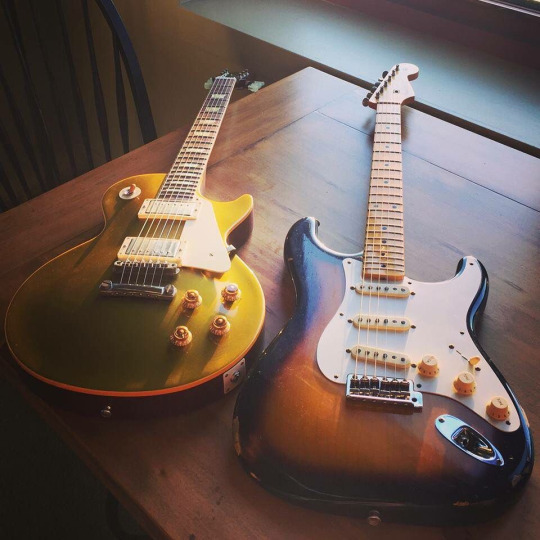

The top picture is the two most famous electric guitar models ever made. On the left, a reissue 1957 Gibson Les Paul “Goldtop.” On the right, a reissue 1957 Fender Stratocaster. The bottom picture is the third most famous electric guitar model, an original 1952 Fender Telecaster.
Fun exercise time...I’m going to take every guitar player I mentioned in my Greatest Guitarist Series, and mark if they primarily played one of these three models. I’m going to strike any classical musicians, (non-fusion) jazz musicians, acoustic-primary guitarists and guitarists who made their impact before the Korean War.
Jimi Hendrix STRAT
Eddie Van Halen *MODIFIED STRAT
SRV STRAT
Andres Segovia
John McLaughlin
Jimmy Page LES PAUL
Eric Clapton STRAT (also played Les Pauls)
David Gilmour STRAT (has played all 3)
Steve Vai
Danny Gatton TELE (has played all 3)
Julian Bream
Chet Atkins
Pat Metheny
Duane Allman LES PAUL
Les Paul LES PAUL
Ry Cooder STRAT (has played all 3)
Yngwie Malmsteen STRAT
Keith Richards TELE (has played all 3)
Wes Montgomery
Tony Iommi
BB King
Charlie Christian
John Petrucci
Prince TELE
James Hetfield
John Jorgenson TELE
Chuck Berry (has played Les Pauls and Teles...famous for ES-335)
Robert Johnson
Steve Howe (has played Les Pauls and Teles...famous for ES-175)
Joe Pass
Al DiMeola LES PAUL
Django Reinhardt
James Burton TELE
Brian May
Jerry Garcia (has played Strats and Les Pauls)
Paco de Lucia
Paul Gilbert
Eric Johnson STRAT (has played all 3)
Brent Mason TELE
Shawn Lane
Muddy Waters TELE
Buckethead
Billy Gibbons LES PAUL (also plays Teles)
Slash LES PAUL
Larry Carlton (has played all 3, but his nickname was Mr. 335)
Frank Zappa STRAT (has also played Les Pauls)
Christopher Parkening
Marty Friedman
Robben Ford TELE (has played all 3)
Jeff Beck STRAT (has played all 3)
Buddy Guy STRAT
Lowell George STRAT
Mark Knopfler STRAT (has played all 3)
Ritchie Blackmore STRAT
Elmore James LES PAUL
John Lee Hooker
Joe Satriani
Woody Guthrie
Hank Marvin STRAT
Kirk Hammett
Dimebag Darrell
Jerry Reed TELE
That is a decent representative list of great guitar players, and those three models...the Fender Telecaster, Stratocaster and the Gibson Les Paul...account for the easy majority. And even if a guitarist wasn’t known for one, they likely recorded with one at some point in their careers.
It’s easy to know where to attribute Fender’s success...Leo Fender was an engineering genius. Gibson, however, had an established reputation long before they ventured into the solid-body world...but they wouldn’t have made that transition if not for Les Paul.
***
The State of Things Today
Before we get into the feud, it’s probably a good idea to get to know where each of these two companies are today. The companies we’re going to talk about in 1952 bear little resemblance to each in the modern era, having both been passed from numerous ownership groups.
I’ve talked a lot about Leo Fender’s ouster at the hands of CBS...which led to the company’s darkest period which took more than a decade to dig out of. CBS themselves were ousted by a group of Fender employees in 1985, and the company they started (they couldn’t use the original facilities) now boasts annual revenues well over $500 million.
It’s reflected by the company’s offerings. Never attempting to be high-end our boutique, Fender’s brilliant branding allowed them to manufacture the same instruments that Leo designed, keeping costs low and making it easy to freshen up long-standing iconic models.
Gibson on the other hand, filed for bankruptcy last year. Long derided for resting on the laurels of their name, Gibson is another victim of predatory private equity...being used merely as a conduit to acquire more debt. Bad news intensifies...they’re also responsible for having strict international regulation regarding the types of wood used. Gibson got in deep doo doo for using illegally farmed woods, and varieties of woods that had been prohibited from foresting due to excessive use (Brazilian rosewood).
Their offerings were staid and stale. Any new innovations were seen by the guitar market as clumsy and hideous. And, making things worse, the nature of their guitars’ construction is much more expensive and labor-intensive than Fender’s ever could be.
Fender will live to see the next 50 years. Gibson likely will not...certainly not under this ownership group.
***

This is Les Paul holding his prototype solid-bodied electric guitar, nicknamed “The Log.” Yes, it looks ridiculous. No, another solid-bodied electric guitar did not exist at the time.
Les Paul had a longstanding relationship with Gibson. Gibson was good to him. Being a jazz guitarist, the whole Gibson lineup was perfect for Les, and they gave him ample ear to chew with all his (at the time) crazy ideas. It was a great partnership.
Me being a Fender fanboy and my comments regarding their business should by no means suggest that I’m not a fan of Gibson guitars. I absolutely love them, especially the Les Paul model. They feel like the guitar version of driving a Cadillac...smooth, comfortable, refined, classy.
But, like I said above, Gibson was a long established company even in the late 1940′s. They didn’t make gimmicks. They made works of art out of the finest woods that produced these beautiful, natural, organic tones. Even their electric hollow-body models replicated an acoustic tone as close as possible. Philosophically, it was going to take something major to get Gibson to budge.
"If you don't do something, Fender is going to rule the world."
-Les Paul
***

When Les Paul received Leo Fender’s prototype in 1951, he knew what it meant.
Sure, it was a gift in the sense that Leo Fender wanted him to have that instrument, but it wasn’t just an instrument, it was an overture. Gibson was a guitar behemoth that dominated an industry that was teetering on the edge of being revolutionized. Fender was that metaphorical disruptor. Both were already well aware of each other.
Fender wanted Les Paul on board, plain and simple. They were hardly even a real company at that point, and getting someone of Les Paul’s status on their roster would be a coup of epic proportions. From a marketing and branding perspective, Les Paul was a guitarist that could’ve established their brand before they even released a product catalog.
But that wasn’t it.
Les Paul’s reputation for having prototype solid-bodied guitars had created waves. He was a recording maven, had a giant audience, and whether Gibson wanted him to or not, exposed people to the sounds possible with a solid-bodied guitar. Leo Fender wasn’t a musician, but he was making the same type of noise within in the industry.
Fender sent out one of his right-hand men who reported back to him on the gift-giving. That dude thought Les Paul was kind of an egotistical dude and didn’t think much of it. Les Paul himself actually did like the instrument a lot...a huge amount given what he said to Gibson execs...and as the two guys who were leading the solid-bodied guitar revolution, there was equal parts kinship and rivalry.

*Les Paul with Leo Fender’s gift...a 1951 “Nocaster”...called that because Fender hadn’t come up with the name Telecaster yet, and there was no model under the Fender logo.
I don’t think it needs to be said that Les Paul ended up staying at Gibson.
***
In 1952, Gibson released their first solid-bodied model that had Les Paul’s name on it. It would define their company. Also in 1952, Leo Fender released the Telecaster (and Precision Bass), the genesis of the company that would grow into the largest guitar manufacturer in the world.
The sheer amount of music that’s been recorded using Les Pauls and Telecasters (as well as the Strat) is simply mind-boggling. It’s almost impossible to quantify.
While the electric guitar industry might be well past the point of peaking, they’re still a major part of American culture. Something that’s come to define us internationally as much as baseball or apple pie. And it’s these three models from Fender and Gibson that so many people are able to instantly identify, that have recorded so much iconic music, that will live on well into the future like a Stradivarius violin or Steinway piano.
And for a brief period in the early 1950′s, it almost came to be that the two most prominent figures in the modern electric guitar world joined forces. Almost. It’s a shame they didn’t...might have been a good thing, given that each was given full creative control without the other’s presence...but the modern musical world was largely impacted by these two guys tinkering around in their basements.
It’s a cool story and easy to let your imagination run wild about what they could have done together.
1 note
·
View note
Text
Urban Fantasy Recommendation Masterpost
This is a list of the urban fantasies I’ve enjoyed most over the years, split down a few lines and to be updated as I discover new series. I’m also including contemporary fantasies because the lines often blur. Hope you find something you like on it!
$ for LGBT characters
£ for characters of colour
€ for characters with disabilities
* for potentially problematic depictions of the above
! for #ownvoices
(all based on my slightly spotty memory, so feel free to correct if I’ve missed something)
World-Focused
or stories that spend most of their time steeping you in the magical world
American Gods - Neil Gaiman £
Shadow Moon gets out of jail and is hired by the cagey Mr. Wednesday to … he’s not really clear, honestly, but it puts him in the path of people who may or may not be gods. Multiple mythologies.
Among Others - Jo Walton €!
A 1980s teen flees her troubled home in Wales to get to know her birth father and attend an English boarding school. Is her mother’s family able to work magic or is it just wishful thinking? Reading science fiction might give her the answers. British folklore and faeries, and a very interesting take on magic.
The Boggart - Susan Cooper
A Canadian family inherits a Scottish castle inhabited by a mischievous boggart—who then stows away and finds himself in Toronto. Scottish folklore.
The Bone Clocks - David Mitchell £
The life of a woman from teen-hood to old age as she lives her life and occasionally intersects with an ancient war between good and evil, fought with telepathy and other things that look a lot like magic.
The Changeling - Victor Lavalle £ !
After his infant son is violently attacked, Apollo Kagwa, used bookseller, descends into the hidden world of New York in search of his vanished wife.
The City We Became - N.K. Jemisin - $ £ ! for race
New York City, newly alive, is being attacked, and six humans, no longer quite human, must do everything in their power to save their city.
the Dark is Rising series - Susan Cooper €*
A group of English kids—four siblings, a seventh son, and a boy who might be a reincarnated Arthur—versus the forces of darkness. Five books, only the last of which includes all the kids. Cornish and English folklores, Arthuriana.
Gods Behaving Badly - Marie Phillips
The Greek pantheon now lives in North London and is as dysfunctional as ever. Artemis walks dogs. Aphrodite does phone sex. Apollo is a washed-out TV psychic who’s just fallen, via Eros, for the cleaning lady—who’s trying to date someone else, thank you very much. Greek mythology.
The Golem and the Jinni - Helene Wecker £
A golem and a jinni both find themselves in turn-of-the-century New York, both literally and figuratively. A beautiful exploration of the immigrant experience, friendship, and identity. Jewish and Arabic folklore.
Good Omens - Terry Pratchett and Neil Gaiman
A mostly-good angel and mostly-wicked demon discover they’ve been training the wrong Antichrist days before the scheduled apocalypse. The real Antichrist wants a dog and to save the whales. Also features a legacy witch, a rookie witch-finder, the Four Horsemen, the Four Other Horsemen, Satanic nuns, and a Queen soundtrack. Christian mythology.
The Hunter’s Moon - O.R. Melling
A Canadian teen visiting her Irish cousin ends up mounting a cross-country road trip to retrieve her cousin who’s run off with the faeries. Irish mythology.
The Left-Handed Booksellers of London - Garth Nix $£
In the summer of 1983, Susan Arkshaw travels to London to find her birth father. What she discovers is a family of magical booksellers, and an Old World that’s very much alive.
Middlegame - Seanan McGuire
Roger and Dodger are exceptionally gifted, telepathically linked, and a little more than natural. James Reed will stop at nothing to use them, or people like them, to get ultimate power. Alchemy, time travel, and portal fantasies are involved.
Neverwhere - Neil Gaiman £
Richard Mayhew has it all: a good job, a hot fiancée, a nice flat. Then he helps an apparently homeless girl with the power to create doors and is pulled into the magical community below London. Nothing will ever be the same.
Of Blood and Honey and And Blue Skies From Pain - Stina Leicht
It’s tough, living in Northern Ireland during the Troubles, and Liam finds it harder than most. No one trusts him, he can’t find work, everyone wants him to choose a side, and to cap it off, he feels like a monster is inside him and knows something inhuman is stalking him and his. The war between the Fey and the Fallen is heating up, and the only people keeping peace are an order of priests—who also, surprise, want Liam’s help. Irish and Christian mythology.
The Sixth World series - Rebecca Roanhorse $£€ !
Maggie Hoskie is a Monsterslayer of Dinétah, but she’d rather not be. Even rescuing a kidnapped girl is supposed to be a one-shot deal. But the monster’s a new one, an apprentice medicine man’s attached himself to her, and Coyote’s around, so of course it’s not that simple. Navajo mythology.
Son of a Trickster - Eden Robinson £€ !
Jared’s life sucks. He’s sixteen, living in a crap house in a crap town with crap prospects. He’s paying his dad’s rent with weed money. His mom’s more interested in parties than holding down a job. His only friend’s a pit bull. And just when he thinks that’s as low as it gets, a raven shows up and say he’s Jared’s real dad. Heiltsuk (and other First Nations) mythology and folklore.
Sparrow Hill Road - Seanan McGuire
Rose Marshall, the Phantom Prom Date, the Ghost of Sparrow Hill Road, hitches her way from coast to coast while dealing with paranormal problems and route witches—and avoiding Bobby Cross, the immortal who killed her.
Sunshine - Robin McKinley
Rae is a baker. Tough and practical and smart, but a baker. Who���s just rescued herself and a vampire from captivity using magic she’d half-forgotten she had. Unfortunately, the master vampire’s still after them, the magical police know something’s up, and she just wants to keep being normal. Includes mild, realistic PTSD and a whole lot of delicious desserts.
An Unkindness of Magicians - Kat Howard
The Turning has started in New York and every magician in the city has their own reason for entering the tournament—power, status, acknowledgement, revenge, revolution. The high stakes would be enough for anyone, but it’s starting to look like there’s something suddenly wrong with magic, too.
Witches of Ash and Ruin - E. Latimer - $ £ € *
Dayna wants to be a witch, live her life, and block her OCD thoughts so she doesn’t have to deal with them. Then scary but gorgeous Meiner and her coven roll into town prophesying Bad Things, and a serial killer reappears who seems to target witches and shit. Meet. Fan. Themes of family and abuse.
Ysabel - Guy Gavriel Kay
Ned Marriner’s tagging along with his photographer dad to Provence when he begins to notice magic awakening around him. There’s an ancient love triangle that‘s repeated throughout history, using contemporary locals as proxies—and it’s very interested in Ned, his new friend Kate, and his father’s entourage.
Mystery-Focused
or stories that spend most of their time solving a magical crime
The Arcadia Project series - Mishell Baker $£€ !
Millie’s nearly broke, scarred, a double amputee, mentally ill, and Done with all the BS around that. She’s also despairing of ever resuming her directing career, so when a mysterious woman offers her a job with her temp agency, she’s intrigued. What wasn’t mentioned? She’ll actually be an immigration agent working with the Fae of Hollywood, and one of them’s just gone missing.
the Blood series - Tanya Huff $£€
Vicky Nelson is the pinnacle of the tough, no-nonsense PI—which poses a bit of a problem when she’s hired to catch a “vampire” on the streets of Toronto and then actually meets one. (He writes romance novels.)
the Felix Castor series - Mike Carey $*
Felix Castor is an exorcist. A hard-drinking, down-at-the-heels exorcist in a London brimming with ghosts and demons. Unfortunately, he never seems to get the easy cases where he can just waltz in and play a tune—and his past mistakes might be coming back to haunt him.
Dirk Gently’s Holistic Detective Agency and The Long, Dark Tea-Time of the Soul - Douglas Adams
Dirk Gently solves mysteries by wandering around, getting into strange situations, and then connecting dots no one believes even exist. Like time traveling robots and Romantic poets, or rampaging eagles and mold-ridden refrigerators.
The Grendel Affair - Lisa Shearin £
Makenna Fraser is a seer working for Supernatural Protection and Investigations in New York. “Seer” meaning she can spot the ghoulies and ghosties few people can, including her coworkers. When an off-the-books gnome removal turns into a blood-soaked crime scene, she and her partner are handed the case—but will her eagerness to prove herself just land her in hotter water?
the Greta Helsing series - Vivian Shaw $£
Dr. Greta Helsing serves the undead of London. Her best friends are vampires and demons. The boundaries between worlds are thinning, causing all manner of metaphysical trouble. Plays with 1800s horror classics; equal parts sensible, disturbing, and funny.
the Greywalker series - Kat Richardson $£
Harper Blaine prides herself on rationality and unflappability, but after briefly dying on a case, she’s suddenly wrong-footed and seeing ghosts everywhere. In the middle of all that, she’s hired by a mysterious voice to track down an organ that’s more than it seems, and suddenly haunted street corners are the least of her problems.
the Incryptid series - Seanan McGuire $£
Meet the Price family, a close-knit group of cryptozoologists whose mission is to protect and preserve endangered cryptids like dragons, gorgons, and the religious Aeslin mice from humans. They’re also hiding from the Covenant of St. George, a.k.a. why the cryptids are endangered in the first place. Technically paranormal romance.
the Iron Druid series - Kevin Hearne £
Atticus O’Sullivan is a herbalist and seller of New Age paraphernalia by day, two-thousand-year-old druid by night. He thought moving to Arizona would keep him safe from gods bent on revenge. He thought wrong. Multiple mythologies.
Last Call at the Nightshade Lounge - Paul Krueger $£€ !
Bailey Chen is fresh out of business school, broke, and living with her parents. When a childhood friend offers her a job as a barback, she takes it as a stopgap—but then she discovers the secret cabal of bartenders who fight demons using magical cocktails and after that, there’s no looking back.
Moonshine - Alaya Johnson £
Zephyr Hollis, a charity worker and ESL teacher in 1920s New York, and therefore flat broke, takes a side job from a student, Amir, without asking questions. But will the vampire mob, the drug-crazed vamps, Amir’s literal smoking hotness, or her family history do her in first?
Night Owls - Lauren M. Roy $
Valerie is a vampire with a successful campus bookstore. Elly grew up fighting monsters and fearing for her life. When their paths collide via a book in Elly’s keeping, they must unite to prevent said monsters from unleashing hell and then some.
the October Daye series - Seanan McGuire $£€
Toby Daye wants sleep, coffee, and for everyone to leave her alone already—not necessarily in that order. Unfortunately, as a changeling Knight and PI with a knack of finding people and solving problems with maximum chaos, none of those things will ever be easy to come by. Multiple folklores.
the Olympus Bound series - Jordanna Max Brodsky $£
Selene di Silva’s been keeping her head down for a long time, shutting herself off not just from New York, but from the world. (Being a former goddess will do that.) But then she stumbles on the body of a woman who’s been ritually sacrificed and her past as Artemis comes rising up again. Greek and Roman mythology
the Rivers of London series - Ben Aaronovitch $£€
When Constable Peter Grant meets a ghost at a crime scene, it’s only logical for him to take a witness statement. When DCI Thomas Nightingale learns of this, he offers him a job as an auror the sorcerer’s apprentice a valued member of a magically-focused police unit. London, its river goddesses, various magic workers, assorted Fae, and the Metropolitan Police will never be the same.
the Shadow Police series - Paul Cornell $£
Following the mysterious death of a suspect, four Metropolitan Police officers are drawn into London’s sinister magical underworld in their hunt for a killer.
the Smoke series - Tanya Huff $*£
Tony Foster’s found his footing as a PA on a Vancouver-shot vampire show. Unfortunately, the paranormal weirdness that is his life continues and it’s somehow up to him to save the day.
Unholy Ghosts (and following) - Stacia Kane £*
Chess Putnam works as a Church exorcist, partly out of obligation and partly for the pay, which goes to fuel her drug addiction. Unfortunately, no ghosts are nice ghosts and her private life keeps intruding on her cases.
the Watch novels - Terry Pratchett
Ankh-Morpork is the citiest of fantasy cities. Its City Watch is a bunch of misfits. Sam Vimes isn’t putting up with any nonsense. Somehow, they fight crime.
Zoo City - Lauren Beukes £
Zinzi December is a con artist and occasional finder of lost things who lives in the Johannesburg slums with her sloth familiar. Her latest case? Find a pair of missing teen pop stars—before the apparent assassins do.
1K notes
·
View notes
Text
Zack Snyder’s Justice League: DC Comics and DCEU Easter Eggs Guide
https://ift.tt/30U8leH
This article contains Zack Snyder’s Justice League spoilers. We have a (relatively) spoiler free review here.
Well, they finally released the Snyder Cut! Zack Snyder’s Justice League is now out in the world (and streaming on HBO Max) and it’s four hours of the director’s undiluted, controversial take on the DC Universe. It’s even more packed with DC history than the “official” theatrical release, if you can believe that, and it builds out the world of the DCEU in some new and unexpected ways.
There’s no shortage of DC Comics Easter eggs in Zack Snyder’s Justice League, and even nods to DC movies of the past. It’s a six course meal of a movie that DC superhero fans should savor, because we’re unlikely to ever see anything like this again.
We’ve tried to find all the DC references and lore in the film. Here’s what we’ve got so far.
The Story
While the Justice League have been around since 1960 (they first appeared in Brave and the Bold #28) the broad strokes of this movie are based on 2011’s Justice League: Origin (which was adapted as the animated movie, Justice League: War), the comic book story that revamped the team’s initial team-up for a new generation. The villain of the comic was Darkseid not Steppenwolf, but the Parademon hordes, the Mother Boxes, and the tying of Cyborg’s origin to Fourth World technology all come straight out of this story.
Steppenwolf DID show up in a contemporary story as well, though. A visually-similar version of the character appeared in DC’s Earth-2, which indicated that Darkseid’s attack on Earth was one that spanned the multiverse, and his lieutenant Steppenwolf ravaged a different Earth, killing its greatest heroes in the process. So that’s two big comics influences out of the way here.
Throughout this movie, Steppenwolf keeps on trying to bring about “the unity” with the three Mother Boxes, but as far as I know, that has no correlation to anything in the comics. If anything, Steppenwolf’s quest and the movie’s backstory has more in common with the Lord of the Rings saga than anything Jack Kirby did, with magical tech being distributed across the different races of the world to keep it from falling into the wrong hands.
Aquaman
Of all the characters in this film, Aquaman seems to bear the most of Zack Snyder’s stamp. It’s incredibly visible just in his eyes, which were “humanized” considerably by the time he appeared in his solo movie.
Snyder’s original vision for Aquaman was clearly something a little grittier than the gleaming underwater fantasy that James Wan brought us. The eerie “hymn” that the women of the village sing to mark Arthur’s departure is a haunting reminder of how these characters are seen in this world.
As Aquaman returns to Atlantis, we see a familiar octopus. Could this be Topo, comic book octopus sidekick to Arthur and famed for his drum solo skills in the Aquaman movie? I’d like to think it is.
Willem Dafoe’s Vulko is here, looking a little different and perhaps a bit less kindly than he did in Wan’s film. Interestingly, he refers to Arthur as “the king who would be man,” an inversion on “the man who would be king,” and a shot at Arthur for not taking his rightful place as heir to the throne of Atlantis. For his part, Arthur’s refusal on the grounds that the Atlanteans are a “brutal, petty, superstitious people” also hints at broader visions Snyder had for the character.
Read more
Comics
Aquaman: Complete DC Comics Easter Eggs and DCEU Reference Guide
By Mike Cecchini
Movies
Aquaman 2: James Wan Promises More Serious Tone, New Worlds
By David Crow
It’s interesting to note that Mera and other Atlanteans speak with English accents here, where they didn’t in the Aquaman movie. It’s a proud tradition of making alien races speak with an English accent, one perhaps most famous in superhero movies thanks to virtually the entire population of Krypton in Richard Donner’s Superman: The Movie.
Similarly, Atlanteans don’t speak underwater here as they do in the James Wan film, instead creating bubbles of air in which to communicate like land-dwellers. It’s pretty cool.
The song that plays when Arthur vanishes into the waves is Nick Cave’s “There is a Kingdom,” and its lyrics are pretty much as on-the-nose as you might expect.
Aquaman spearing two Parademons with his trident reminds me of this moment from Justice League: Origin, as well…
Is Aquaman the first person to call Bruce “Batman” in the DCEU? In Batman v Superman it was all “the Bat” this and “the Gotham Bat” that.
Speaking of Batman…
Batman
When we first see Bruce Wayne searching for the mysterious Arthur Curry, he’s riding a jet black horse, which is very similar to the steed he rode in some famous pages of Frank Miller, Klaus Janson, and Lynn Varley’s classic and influential The Dark Knight Returns, a work which has considerable influence on how Batman was portrayed here and in Batman v Superman: Dawn of Justice.
If you look closely you can see a 201 area code on Bruce Wayne’s business card, which further confirms that Gotham City is on the New Jersey side of the river that separates it from Metropolis.
This movie, like Batman v Superman before it, reminds us that we’re dealing with a Batman who has been active for 20 years. It’s yet another reminder of the influence of The Dark Knight Returns on the DCEU vision for Batman, depicting him as a much older, more experienced crimefighter.
Let’s just take a moment to appreciate how good Jeremy Irons is as Alfred Pennyworth. His line about “someone who broods in a cave” is classic Alfred shade (as is the moment later on when he is totally micromanaging how Diana makes tea). See also: Bruce’s joke about how he works for Alfred.
Bruce tells Alfred that he “made a promise to him [Superman] on his grave.” As we well know with Bruce and his parents, when he swears on someone’s grave, it’s a promise he takes very seriously.
Read more
Comics
Batman v Superman: Dawn of Justice – Complete DC Comics Easter Eggs and Reference Guide
By Mike Cecchini
TV
The Batman Animated Series You Never Saw
By Mike Cecchini
We meet Kobna Holdbrook-Smith as Crispus Allen very briefly in Gotham PD HQ talking to JK Simmons’ excellent Jim Gordon. Detective Crispus Allen was a Batman supporting character who played a significant role in the excellent Gotham Central series. While we don’t get any hint of his future here, Allen went on to become the human host of the Spectre after he was murdered by a corrupt colleague.
Barry asks Bruce incredulously, “you have a satellite?” to which Bruce calmly responds, “I have six.” It feels very much like something Grant Morrison’s Batman would say (he even owns a flying saucer), but it ALSO hints at the fact that for many years, the Justice League operated out of a satellite HQ. Perhaps Bruce would consider moving the team up there in future installments.
During the big battle at the end, there’s a terrific shot of Batman that mirrors his first appearance in Detective Comics #27.
There’s a pretty clear shot of the Bat-tank that is a very direct nod to a panel from Dark Knight Returns.
Cyborg
It seems like all the flashbacks to Vic Stone’s pre-Cyborg college days take place in 2015, so it’s after the events of Man of Steel, but he has only been “Cyborg” for a relatively brief period here.
Thanks to the backstory in this version of the film, we learn that Vic is already a genius level intellect. Although in the comics it was because Drs Silas and Elinore Stone were already experimenting on their son long before the accident that forced them to turn him into Cyborg.
Interestingly, the origin story here is neither the classic comics origin nor the New 52 version (surprising, since so much of this film feels inspired by the New 52 Justice League: Origin story). There, it was either an accident with interdimensional energy or the opening of a Mother Box/Boom Tube which virtually destroyed Victor’s body and caused the creation of Cyborg.
What is the Dean of GCU’s name? It looks like it might be “Dean Stanton” which would be a lovely tribute to actor Harry Dean Stanton (but there’s no DC Comics connection here in that case).
You may note that the scoreboard for Gotham City University was built by Wayne Enterprises.
It’s probably a coincidence, but Cyborg financially helps out a “Linda S. Reed.” In the comics Linda Reed was a short-lived Green Arrow character who (along with her twin sister Ramona) went by the uninspiring name of “Girl Archer.”
Since Vic Stone has traditionally been a Teen Titans character, and he and Barry are by far the youngest members of the League, it makes sense that they would bond. Especially since this version of Barry Allen has more in common with the comic book version of Wally West than anything else, and Wally was a member of the Titans with Vic.
The Flash
When we first meet Barry Allen he is late to a job interview. This isn’t just a play on “oh, the fastest man alive is actually really slow” or something, Barry’s habitual lateness was baked into the character in his very first appearance back in Showcase #4. Similarly, even his predecessor, Jay Garrick was known for this not terribly charming trait, too.
Interestingly, Barry’s persona in the DCEU feels much more in common with the Wally West of the DC Animated Universe. He’s the less experienced hero, a kind of point-of-view character, and generally younger and funnier than his teammates. But the more specific Wally reference is his need to consume tremendous quantities of calories to keep going (his “snack hole” crack), something that was unique to Wally among Flashes (but which was also utilized when John Wesley Shipp played Barry on the 1990 The Flash TV series).
That’s Billy Crudup as Henry Allen in jail (who sadly won’t be reprising his role in Andy Muschietti’s The Flash movie) The whole “hands on the glass” thing was done quite a bit between the TV versions of these characters, played by Grant Gustin and the great John Wesley Shipp. Henry’s line to Barry that he should “make your own future” would seem to foreshadow the events of Flashpoint, as well.
But there’s one other similarity to the TV show worth pointing out…
Henry is rocking the Jay Garrick look with the grey hair at the temples thing. With certain developments on The Flash TV series, this could also be an indicator of how things will be handled in the DCEU. I wrote lots more about Jay Garrick, one of my favorite characters, right here.
Barry notes to Bruce that he is fluent in “gorilla sign language,” which could come in handy down the road should he encounter a race of superintelligent gorillas who have started their own civilization or something like that.
Is Barry wearing a “Black Freighter” t-shirt? As in the pirate story that is woven through the Watchmen comics? You don’t need me to remind you that Zack Snyder also directed a Watchmen movie, right?
If you look at Barry’s desk, there’s a photo of Nikola Tesla there, which makes sense given Flash’s whole aesthetic.
One fun thing about Barry’s personal HQ: If you look carefully on one of the TVs, you can spot that he’s a Rick and Morty fan, and a particular season two episode, which involves a chemically-enhanced Summer and Rick beating the crap out of unsavory types like Nazis, is playing in the background.
It’s interesting to note that Barry is only now just on the path to becoming a police scientist, rather than already having been driven to do so. It’s almost like his time with the Justice League inspires him to do more with his professional life, as well.
Read more
TV
The Flash TV Episode We Almost Saw
By Mike Cecchini
TV
Stargirl Season 2 Will Put The Flash in the JSA Where He Belongs
By Mike Cecchini
It’s interesting that the Barry Allen of the DCEU is Jewish, if only because we’ve never had any hint of Flash’s faith (or lack thereof) in the comics or on the TV show. The closest Barry Allen has to any kind of religious or ethnic identity has always been “midwestern.” Brian Cronin at CBR thinks this could be a reference to a throwaway line from a late ’80s DC story, but I don’t necessarily think that’s considered canon. I’m open to corrections, though!
Iris West
We see the first meeting between Barry Allen and Iris West here. I don’t know the exact make and model of the vintage convertible that Iris is driving (if anyone does, please give us a shout in the comments or on Twitter), but it feels like it COULD be from the year 1956, when Showcase #4 was published. Similarly, the excellent and underrated The Flash TV series from the 1990s used to populate the streets of its version of Central City with vintage cars to give it a “timeless” feel.
Speaking of Showcase #4, the fact that hot dogs are among the things kind of hovering in midair thanks to Barry moving at super speed is another nod to the character’s first appearance, when one of Barry’s first super speed acts was to catch a spilled tray of food in a diner in mid-air before the waitress knew what had happened.
What’s the brand of fast food the truck driver is eating? I can’t quite make it out. It would be cool if it was a Big Belly Burger with a Soder Cola, but I think it might just be something lame like “Burger Shop.” Help me out, folks!
The truck that nearly kills Iris is for a company called Gard’ner Fox, a reference to classic Flash writer/co-creator Gardener Fox.
You can see a newspaper box for The Central City Tribune, which hints at the fact that Iris West is a journalist in the comics.
Superman
Martha’s dog’s name is Rusty, which I THINK is a reference to a briefly glimpsed pooch in Richard Donner’s Superman: The Movie. But I can’t fully confirm that as of this writing.
Lois Lane’s depression and loneliness is soundtracked, appropriately enough, to “Distant Sky” by Nick Cave and the Bad Seeds (Mr. Snyder seems to love the work of Nick Cave), which features lyrics like “They told us our gods would outlive us,” but there’s lots here that mirrors the journey of these heroes in the film.
The Daily Planet’s slogan in the DCEU is “reporting on the planet, daily” which seems a little on-the-nose to me, but whatever. It’s had several in the comics, but in Richard Donner’s Superman it was “Metropolis’ Greatest Newspaper.”
When the Motherbox generates the image of Superman flying, it’s a classic Superman pose this is. This is a really cool shot, and looks like a Curt Swan/Murphy Anderson drawing of the Man of Steel come to life.
During the return to the Kryptonian ship that served as the de facto Fortress of Solitude in Man of Steel (and which gives Supes his black costume here), we can spot the open pod that launched so many fan theories in 2013. A possibly no-longer-canon Man of Steel prequel comic that was nonetheless written by David Goyer implied that it was Kara Zor-El who was in that pod, and who has roamed the DCEU undiscovered thus far.
You can hear moments of Hans Zimmer’s truly excellent Man of Steel score at key Superman moments throughout the film, too.
Clark Kent was buried in a conservative dark blue business suit, with a red tie, and black shoes. That is the exact outfit that the comic book version of Clark Kent wore in virtually every single comic book appearance from roughly 1938 until 1986. Henry Cavill’s Clark was a little more fashionable in life, but not in death.
Read more
Movies
Man of Steel: Complete DC Comics Easter Eggs and References Guide
By Mike Cecchini
Movies
Superman Movies Ranked: The Best and Worst of the Man of Steel
By Mike Cecchini
When Superman wakes up, well, it’s not pretty. This scene serves two purposes, though. For one thing, it demonstrates how he is more powerful than the entire team combined, lest anyone think that Superman is lame. But his disorientation and raw fury are a slight nod to how in the comics and cartoons, at several points, Superman has been manipulated by Darkseid. While that doesn’t quite happen here, the role of Fourth World technology in his resurrection feels like it’s not a coincidence.
Clark “returning” to himself in the field in front of his Smallville home and being greeted by Martha Kent feels like an inversion of Clark leaving home in Superman: The Movie and bidding his mother farewell. He’s wearing a similar flannel shirt in both scenes, too.
As Clark completes his journey and “returns” to being Superman, complete with the cool new costume (more on that in a second), we hear the voices of BOTH his fathers, both Jor-El and Jonathan Kent. It’s yet another nod to Richard Donner’s Superman, when Kal-El was guided by the voice and spirit of his Kryptonian father when he first wore the suit. And, of course, his takeoff here mirrors his first flight in Man of Steel, completing his “rebirth.”
The black and silver Superman suit was a fixture of Reign of the Supermen, the story that brought the recently deceased Man of Steel back to life. In the comics, it was a kind of regeneration suit, meant to help harness solar radiation for Superman’s cells. It’s not clear if it is meant to serve that purpose here, since (as we see when he kicks the entire League’s ass) he was already at full physical (if not mental) power upon his resurrection. It’s been done several times in live action too, but it has never looked as good as it does here.
Amusing detail about the Kent Farm being foreclosed on…there’s already some awful suburban McMansion built right across the road.
Marc McClure who played Jimmy Olsen in the Donner Superman films played an Iron Heights prison guard in the theatrical cut of the film, but here he is the cop guarding the Superman memorial in Metropolis.
And the final true shot we see of Superman in the film, with Clark Kent becoming aware of trouble and doing the classic “shirt rip” is another iconic moment from throughout the character’s history, although it’s never better than it is in Superman: The Movie right before the big helicopter rescue. It’s worth noting that in the theatrical cut, Supes was back in the red and blue, while here he has chosen to stay in the black and silver.
Wonder Woman
One of the big takeaways from Wonder Woman’s intro sequence is that even mundane villains in the DCEU are cool, stylish, dangerous, and they don’t think small. These guys are the face of a mysterious organization who want to “turn back the clock” but I have yet to find a suitable DC Comics parallel to them.
Of course, the statue we see Wonder Woman standing on is Justice herself.
Diana’s white dress while she’s working on restoring the statue feels vaguely reminiscent of her “mod years” in the late 1960s, where she briefly ditched her primary colored costume to fight in something a little more practical.
Read more
Movies
Wonder Woman 1984: DC Comics Easter Eggs and Reference Guide
By Delia Harrington
Movies
Wonder Woman 1984 Post Credits Scene Explained
By Mike Cecchini
Wonder Woman wearing an appropriately stylish black getup when visiting Bruce in the cave kind of reminds me of Wonder Girl Donna Troy’s star-spangled black outfit that she wore for a little while…but that’s probably just a coincidence.
Diana tells Bruce that she “once knew a man who would have loved to fly it” regarding Bruce’s flying troop transport for the League. She is, of course, referring to Steve Trevor, but this line takes on a little bit of extra weight after we see Steve flying more modern aircraft in Wonder Woman 1984.
At one point in the film, Diana hints that Atlantis and Themyscira had been at war at one point in the past. This has been teased in the comics several times and came to a head in the Flashpoint comics.
There’s a cool moment when Steppenwolf tells Wonder Woman that she has “the blood of the old gods” in her veins. When Jack Kirby created the New Gods and the Fourth World, he was still working for Marvel. The original plan was for the Asgard of Marvel’s Thor comics to undergo a Ragnarok, everyone would die, and in its place would be these New Gods. Obviously that didn’t happen, and the concepts ended up at DC. But that one line, tying Diana’s Greek mythology roots directly to the cosmic New Gods of the DCEU, is surprisingly in keeping with Kirby’s original intention.
Ryan Choi
We get another hero snuck into the mix in this movie, in the form of STAR Labs’ Ryan Choi (played by Zheng Kai). While he doesn’t suit up in this film, Choi was the inheritor of Ray Palmer’s mantle as the shrinking superhero, the Atom.
By the end of the film, Choi is given the title of head of nanotechnology for STAR Labs, further setting up his future as a hero.
Green Lantern
While no Green Lantern remains alive for long in this film, there are plenty of references to the Green Lantern Corps throughout…
Steppenwolf promises that there are “no protectors, no Lanterns, no Kryptonian” guarding Earth this time, which is pretty self-explanatory.
This member of the Green Lantern Corps we see fall in battle during the flashback sequence is Yalan Gur, a character who has only made a handful of appearances in the comics. Gur was indeed the Green Lantern of space sector 2814 (that includes Earth) around the time this battle would have taken place. In the comics, Gur was corrupted by his own power and turned on the humans of Earth, but he clearly didn’t get that chance in the movie, as he was killed by Darkseid in the flashback.
During the vision of the future where Darkseid has gained control of the Anti-Life Equation, another dead Green Lantern can be spotted amongst the rubble of a ruined city. That would be of Green Lantern Corps drill sergeant and fan favorite, Kilowog. This is Kilowog’s second live action appearance, if you count 2011’s not great Green Lantern movie with Ryan Reynolds.
Darkseid
Steppenwolf tells the Amazons that he “has come to enlighten you to The Great Darkness.” The Great Darkness is more than just a reference to Darkseid himself and his entire philosophy, but is also a reference to what is perhaps the ultimate Legion of Super-Heroes story, The Great Darkness Saga, by Paul Levitz and Keith Giffen, which saw a long dormant Darkseid return to life to terrorize the galaxy a thousand years from now.
When Darkseid strikes the surface of the Earth with his axe, it creates the kind of hellish firepits that his homeworld of Apokalips is famous for.
Darkseid taking on the literal “old gods” of Earth including Zeus, Ares, Apollo, and Poseidon is a fun contrast with the fact that he is part of DC’s “New Gods” mythology.
Darkseid is searching for the Anti-Life Equation, which we wrote more about here.
During Darkseid’s “vision” of the universe once he has obtained the Anti-Life Equation, we can see Superman holding a charred corpse, which is presumably the body of Lois Lane. This apparently sets him up for corruption by Darkseid, and helps bring about the “Knightmare” vision from Batman v Superman, which is once again glimpsed at the end of this film.
The third figure we see on Apokalips with Darkseid and Desaad appears to be Granny Goodness, the chief of the armies of Apokalips (and the one who trained/traumatized DC heroes Mister Miracle and Big Barda).
Parademons
The weird insectoid drones making everyone’s lives miserable are Parademons, the foot soldiers of the planet Apokolips, a hellish world which lives in opposition to New Genesis, the home of the New Gods and Forever People. All of this great stuff was created by the brilliant Jack Kirby, by the way. Steppenwolf (more on him in a minute) and the Parademons are trying to collect three Mother Boxes left on Earth.
What is a Mother Box?
The Mother Box is the unifying piece of technology of Jack Kirby’s Fourth World epic. Think of a Mother Box as an alien smartphone that can do anything from heal the injured to teleport you across time and space. It’s pretty cool hearing their trademark “ping. ping. ping.” sound for real.
Mother Boxes are often used to call down Boom Tubes, the preferred method of transport of the New Gods and their friends and foes. We see them deployed quite a bit throughout this movie, obviously. Super Powers fans of the 1980s may remember that on Super Friends: Galactic Guardians, boom tubes were referred to as star gates.
It’s POSSIBLE that the knights burying the Mother Box are meant to be King Arthur and his crew, while the one with the horns could be Sir Bors. They relatively recently appeared in Demon Knights, but they were best in Seven Soldiers of Victory, where the Knights of the Round Table fought an invasion from evil Faeries and lost, only to have Sir Ystina, the Shining Knight, help save the world in the present day. Honestly, that sounds like it would be pretty up Zack Snyder’s alley too, now that we think about it.
Mother Box is cataloged as “unknown object 61982” after it has been discovered in the modern world. So far, I haven’t been able to find any DC Comics or DCEU significance to that number.
DeSaad
DeSaad is Darkseid’s chief advisor and torturer-in-chief (hence the name). Like all the other cool Fourth World stuff in this movie, he was created solely by the legendary Jack Kirby. He first appeared in Forever People #2 in 1971.
It’s kind of cool that the nameless “Motherbox priestesses” kind of look like DeSaad, too.
Steppenwolf
Steppenwolf is the first Jack Kirby creation to show up in a DC superhero movie (for comparison, nearly the entire Marvel Cinematic Universe owes its entire existence to Jack Kirby). They don’t really give us much to go on with Steppenwolf in this flick, but to be fair, he wasn’t one of Kirby’s most inspired creations and it’s not like he has the longest comic book history. In the comics, Steppenwolf was Darkseid’s uncle, and responsible for the war between Apokolips and New Genesis, but here he appears to be his nephew instead.
In a lot of ways, particularly his appearance, this version of Steppenwolf seems to owe more to his appearance in DC’s New 52 version of the Earth-2 comics than he does any of Kirby’s vision.
The weird little spider-y device that Steppenwolf uses to get information on people looks a lot like Starro, the first villain that the Justice League ever fought in the comics, right down to the way it attaches to people’s faces.
Martian Manhunter
We get our first long-promised revelation of Martian Manhunter in the film, who, as it turns out, had been masquerading as Harry Lennix’s General Swanwick the entire time.
Martian Manhunter finally revealing himself to Bruce at the end kind of completes Bruce’s journey from vaguely fascist xenophobe in Batman v Superman to someone far more heroic.
Martian Manhunter says he has “gone by many names” but doesn’t mention any of them. It doesn’t make sense why he wouldn’t have introduced himself as J’onn J’onnz (his Martian name). Other names he has gone by include Detective John Jones (not in the movies), and as we’ve seen in this very film, General Swanwick.
While we don’t get to see Martian Manhunter officially join the Justice League here, his presence in the film kind of completes the “unite the seven” tease that dates back to Batman v Superman. Martian Manhunter has always been depicted as a founding member of the team, both in comics and in the excellent Justice League animated series.
Deathstroke
We get a LITTLE more of Joe Manganiello’s Slade Wilson in this movie than we did in the theatrical cut…
In the theatrical version, Lex had summoned Deathstroke in order to start assembling a Legion of Doom-esque team of supervillains. But here it’s to give him Batman’s true identity. Apparently this would have helped set Deathstroke up as the villain of the Ben Affleck-led Batman solo movie, which would have featured Deathstroke dismantling Bruce Wayne’s life, Daredevil: Born Again style.
We see Deathstroke again during the epilogue where Slade (who is more of an antihero in the comics) has joined Batman’s ragtag group of freedom fighters against Darkseid and the forces of Apokalips.
Speaking of that epilogue…
Joker
No, your eyes do not deceive you, that is indeed Jared Leto returning as the Joker, marking his first appearance in the role since his controversial turn as the character in the Suicide Squad movie.
So…it appears that the “Knightmare” sequence in Batman v Superman wasn’t a vision of this movie after all, but rather for the Justice League 2 we’ll never see. And it’s up to Jared Leto’s Joker of all characters to explain this to us once and for all.
It seems that in a not-too-distant future, Darkseid’s armies have indeed come to Earth, and he is either in search of or has claimed the Anti-Life Equation, having murdered Lois Lane, turned Superman to evil (god, why does Zack Snyder love this idea so much), leaving a ragtag group of heroes and villains to try and set things right.
The death of Lois Lane at the hands of a villain turning Superman into a maniac feels quite a bit like the storyline of the Injustice video game.
Joker makes several allusions to having murdered Robin, which in the comics would be Jason Todd, although Snyder has hinted before that the dead Robin in question was actually Dick Grayson (hence, no Nightwing in the DCEU).
The notion of Batman and Joker teaming up in any capacity isn’t one with a whole lot of weight in the comics, but them coming together in a post-apocalyptic landscape with Joker acting as a kind of truth-teller for Batman is faintly reminiscent of Scott Snyder and Greg Capullo’s Batman: Last Knight on Earth.
Joker’s hints that Batman needs to die in order to set things right are reminiscent of Grant Morrison’s superb Final Crisis.
Lex Luthor
Lex Luthor’s escape from Arkham Asylum (side note, it has always rubbed me the wrong way that they keep Lex at Arkham…that isn’t where you put Lex Luthor) with a fakeout vaguely reminds me of how he escaped from prison in Superman II, which involved using a hologram to fake out the guard. The guard’s response to “Lex” not doing what he’s supposed to here is similar, too.
When we finally see Lex for real, it’s on the yacht, and his loud outfit is more than a little bit reminiscent of how Gene Hackman’s Luthor dressed as Lex in the Superman movies of the 1970s and 1980s.
Miscellaneous Stuff
Bruce returns to the ruins of Wayne Manor which he intends to convert into a headquarters for the newly formed Justice League. But placing a roundtable in a mansion has a little bit more of a Justice Society of America vibe to it…but that’s just a coincidence. However, we’ll be meeting the Justice Society in the upcoming Black Adam movie.
There’s a headline in The Daily Planet that says “Security Bank of Manhattan Sets New Architect.” No, this isn’t a John Stewart Green Lantern reference. Instead, it’s a nod from Snyder to the character of Howard Roark, the protagonist of Ayn Rand’s The Fountainhead, a favorite of the director’s and a project he once hoped to adapt into film. In that book, Roark is an architect who is commissioned to work on the “Security Bank of Manhattan.” Draw your own conclusions about Snyder’s love for this book and Rand’s work, however.
That isn’t the only Ayn Rand reference in the film, either. The fishing boat that Aquaman rescues is called the Cortlandt, a reference to a housing development in The Fountainhead.
The place where Lois gets her coffee is “Fred and Ginger Coffee” as in Fred Astaire and Ginger Rogers. Also, if you look really closely in the window of the coffee shop as she leaves, there’s a man at a table wearing a vest. I’m not 100% sure, but I THINK this is Zack Snyder giving himself a Hitchcock-esque cameo in the film.
The STAR Labs janitor who goes missing/gets eaten by Parademons is apparently named Howie Jensen. Whenever there’s a janitor in a top secret area working with alien tech in the DC Universe, my mind immediately goes to Superman villain, the Parasite. The most famous version of the Parasite was Rudy Jones, a STAR Labs janitor who ended up wallowing in some toxic waste (perhaps coincidentally because Darkseid manipulated him into it). Anyway, this isn’t Rudy Jones, so it can’t be the Parasite right? Well…mostly. There was a previous Parasite names Raymond Jensen…which seems to be our poor, doomed, pal Howie’s name in this.
When Bruce leaves Barry’s lair to drive to the Central City Airport, there’s an American Foundation for Suicide Prevention billboard that says “You are not alone,” a nod to the work Snyder has done to help raise awareness for their cause. You can learn more about them here.
During Darkseid’s vision of the future he wants, there’s a ruined Hall of Justice, the Justice League headquarters first made famous on the Super Friends cartoon and which, in more recent years, has become a fixture of the comics.
The pregnancy test in Lois’ nightstand is named, we kid you not, Force Majeure.
cnx.cmd.push(function() { cnx({ playerId: "106e33c0-3911-473c-b599-b1426db57530", }).render("0270c398a82f44f49c23c16122516796"); });
Spot anything we missed? Let us know in the comments!
The post Zack Snyder’s Justice League: DC Comics and DCEU Easter Eggs Guide appeared first on Den of Geek.
from Den of Geek https://ift.tt/3ltBVAY
0 notes
Text
Better Fights Than Superman Vs. Goku
As long as comic books and manga exists, there will be at least two people arguing about who can take who in a fight. That is a constant that I have learned.
In fandom, there are debates about the levels of power heroes and villains have, the types of feats they have to qualify for a win and loss, morals, strategies, and so on. However, while there is many debates and many matchups that have been put out there, there is one that I can never seemingly have a pure definitive answer for myself: Superman vs. Son Goku.
I’m not going to bore you with the background story for these two heroes. And, to be frank, I don’t really think I’m going to give you a definitive answer about the type of fight these two can have. There are so many variables to consider, not to mention the history these two have (and considering that Dragon Ball Super, a new manga/anime series, is giving Goku new powers to use, I’m not even going to try to gauge their strengths at this moment), picking a winner for me boils down to “who do I like more” and I can’t really do it.
Also: I’M GETTING BORED ABOUT DEBATING THIS.
So, what am I doing? Simple really; I’m proposing other worthwhile matches that you should consider discussing. The following are fights I think are more worthy of debate for fans of comics/cartoons and anime/manga and should make for some interesting questions and analysis. You may be surprised by some of the fights I propose. First up-
Iron Fist (Marvel) vs. Might Guy (Naruto)

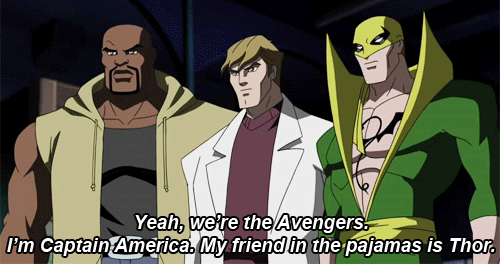
This one was not taken lightly by me, especially given what I know of the two. Danny Rand, a martial arts master, manipulates chi and the power of the dragon Shou-Lao to enhance his body and his abilities to super hero levels. Might Guy, a taijutsu master, can tap into the 8 Gates, which can grant him even greater superhuman strength, speed and agilitiy. And given what Guy does during the events of the 4th Shinobi War, Danny would really be tested.
Samurai Jack vs. Goemon (Lupin the 3rd)
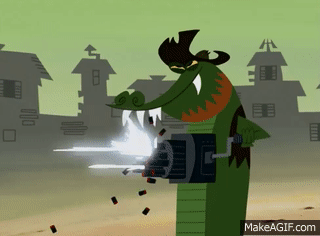

I know a lot of you know who Jack is, but you probably may be thinking “Who da hell is GOEMON?” I’ll give you a heads up: Goemon is based on a historical figure, Goemon Ishikawa. (His full name in the series is Goemon Ishikawa XIII). Like Jack, he is a samurai swordsman who is a skilled fighter (Both of these guys are trained in multiple styles) And like Jack, he has a mystical type of sword. (Zantetsuken, a sword made from a meteorite, which can slice through anything) And if you think Jack’s feats were remarkable, you ought to see all the crazy stuff Goemon has been up to in the entire history of the Lupin the 3rd series. (To give you a small example, he has cut through skyscrapers, tanks, squads of armed men and LIGHTNING. I shit you not on that one.) It was no accident that there is a character in Samurai Jack that is based on two Lupin the 3rd characters. I would not be surprised if Jack was inspired by Goemon too.
Popeye vs. Monkey D. Luffy (One Piece)
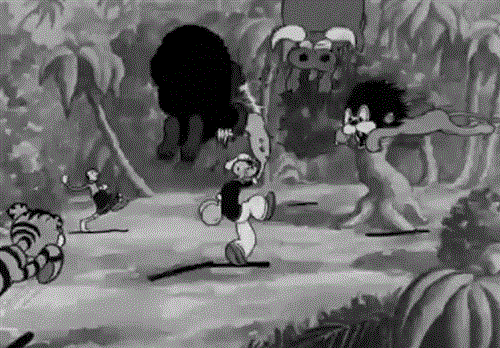
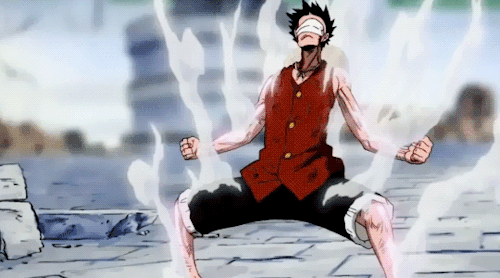
Another fight that a friend of mine, Katie, had suggested in the past and, quite honestly, this one is more interesting. Two men of the ocean, both of questionable intelligence, fighting it out to see who is the baddest man to sail the seven seas. And also both are ridiculously durable. Seriously, ever see what Popeye goes through WITHOUT eating the spinach? And Luffy can take some serious beatings. (Look up with fight with Rob Lucci)
HOWEVER…there is one other opponent I’d like to see take on the captain of the Straw Hat Pirates.
Reed Richards vs. Monkey D. Luffy
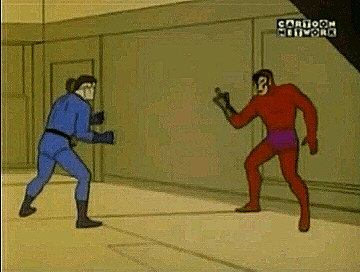
This is a little more logical as both have similar powers. The key difference here is that while Reed Richards may have the intelligence to constantly have Doctor Doom curse his name, Luffy is more of a fighting type of brilliant. And that’s actually important considering all of the opponents that he has bested in combat who are way more intelligent than him. It would be interesting to see how Reed would fare.
Ok this next choice…this one is a doozy because well…just see for yourself.
Freakazoid vs. Bobobo (Bobobo Bo Bo-bobo)


There is no possible way I could accurately describe the chaos involved in a fight like this. For starters, Freakazoid works on a level of random comedic genius we don’t get to see that often and the character himself can’t quite be defined in a conventional term other than “batshit crazy”. And on the other side, we have a manga series that operates purely on frequent and random acts of pure comedic insanity. (Seriously, Fist of the Nose Hair.) In order for me to even consider writing the script for this fight, I would need to be stoned out of my mind. Or, barring that, tripping on serious peyote. But lets face it, it would be funny. So funny it would be illegal.
Now, strictly speaking one of the people involved in this one is from a book series. I’m going to let it slide on the basis that the other series stared as a Light Novel.
Lord Voldermort (Harry Potter) vs. Lina Inverse (The Slayers)
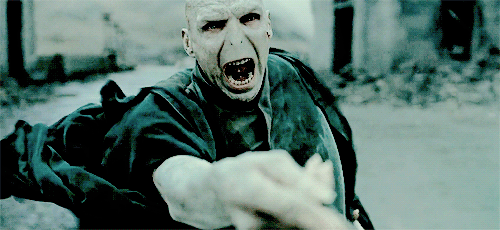

One of these people is a powerful master of magic, wielding powers far beyond our comprehension, whose very name strikes terror in even the most fearsome of creatures and has been responsible for a lot of destruction, leaving even towns burning behind. The other is Voldermort.
Both of these people are respective geniuses at their craft and have gained knowledge of various magic styles. What separates them however is morals; yes Lina DOES have morals despite the fact she likes getting paid handsomely for her services and DESPITE her many nicknames (Like “Enemy of All Who Live”, “Lina The Pink”, “Lina The Bandit Killer”, “Empress of Destruction”, “Natural Disaster Mage”, “No Breasts Demon”—)
Me: Oh shit, I didn’t mean to—
Lina: DRAGON SLAVE!!!!!

…as I was saying, the very lovely noble and kind magic user who is merciful to all her foes (I am NOT typing this for fear of my life by the way) has morals whereas Voldermort has no qualms about doing anything to get what he wants. (Dude was willing to a baby because it may have been a threat to him. There’s no grey area there.) Plus, despite being nigh immortal, Voldermort would be hard pressed to fight a mage who knows spells that can hurt your very soul.
So there you have it, some of my choices for a better fight than Superman vs. Goku. And before I go, here is the joke fight that, admittedly, I would be happy to see…
Perry the Platypus vs. Kyuubey
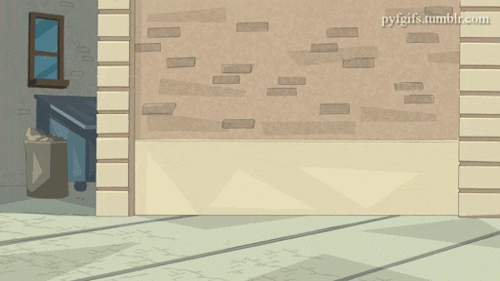
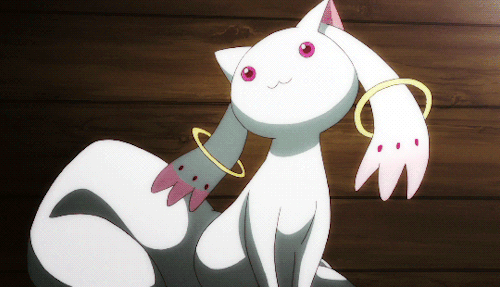
…face it, it would be AWESOME.
#marvel#iron fist#naruro#might guy#samurai jack#lupin the 3rd#goemon ishikawa xiii#popeye#one piece#monkey d. luffy#fantastic four#reed richards#freakazoid#bobobo bo bo bobo#harry potter#lord voldermort#the slayers#lina inverse#phineas and ferb#perry the platypus#puella magi madoka magica#kyuubey
16 notes
·
View notes
Text
Green Lantern: 5 Actors Who Could Play Hal Jordan (And 5 Who Could Play John Stewart) In The DCEU
There’s every chance that the DCEU’s eventual Green Lantern movie won’t revolve around Hal Jordan, since that’s the version Ryan Reynolds played in his despised 2011 movie and Warner Bros. will likely want to distance themselves from that as much as possible. So, the DCEU’s Green Lantern might be John Stewart instead. Fans have wanted to see Idris Elba play John Stewart pretty much since the Green Lantern Corps movie was announced for the DCEU, but he’s since been cast to star in The Suicide Squad in the same universe, so he’s out of the running (unless, although it is a stretch, his Suicide Squad character is John Stewart). Here are 5 Actors Who Could Play Hal Jordan (And 5 Who Could Play John Stewart) In The DCEU.
RELATED: 10 Ways Green Lantern Could Be Introduced In The DCEU
10 Hal Jordan: Jon Hamm

The role of Hal Jordan requires a standard leading man type with an extra degree of charm and humor. That’s what made Ryan Reynolds the perfect choice to play him in the 2011 movie (it’s just a shame that the movie itself turned out to be dreadful). It would also make Jon Hamm a perfect choice; Don Draper is the quintessential dude. If the Green Lantern Corps movie has an older Hal Jordan working with a younger John Stewart, then Hamm is about the right age – he’s believably older, but not too old that the physical action scenes would be unworkable.
9 John Stewart: Trevante Rhodes

Ever since Idris Elba is off the table due to his casting in another DCEU movie, Trevante Rhodes has become fans’ most popular casting choice for John Stewart. It seems as though the Green Lantern Corps movie will be a buddy cop movie with Hal Jordan as the veteran training up John Stewart as a rookie. Rhodes has both the look and the age to pull of John Stewart, and he proved with his turn in the Oscar-winning masterpiece Moonlight that he has serious talent as an actor. Prior to his acting career, he was a track and field star, proving he also has the physicality to play a superhero.
8 Hal Jordan: Karl Urban

Karl Urban has always deserved to be a bigger star than he is. He’s always brought a likable charm to roles like “Bones” McCoy in the Star Trek reboot series and even the cold-hearted, ultraviolent comic book icon Judge Dredd. He even managed to make Skurge the Executioner redeemable in Thor: Ragnarok.
RELATED: Star Trek: 5 Kelvin Timeline Actors We Hope Reprise Their Roles In Quentin Tarantino's R-Rated Movie (And 5 We Don't)
He started off as a follower of Hela, but he realized the error of his ways and sacrificed himself to save the surviving Asgardians. Hal Jordan is that guy – he’s the guy who screws up, but will then do whatever it takes to fix the screw-up and do right by people.
7 John Stewart: Michael B. Jordan

Zachary Levi has proved by playing Fandral in the MCU and then Shazam in the DCEU that it’s possible to appear in both studios’ superhero franchises and not get blacklisted in Hollywood by the one you worked for first. Granted, Michael B. Jordan’s MCU role was a lot larger and more memorable than Levi’s, but that was mostly down to Jordan himself working with Black Panther director Ryan Coogler to develop Erik Killmonger into an all-time classic villain. Jordan could play John Stewart as the by-the-books straight man trying to get the job done opposite Hal Jordan’s goofball man-child act.
6 Hal Jordan: Nathan Fillion
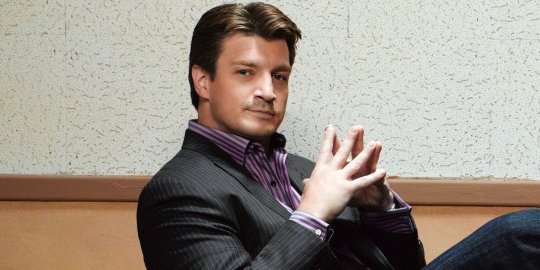
It’s about time Nathan Fillion finally got a starring role as a superhero in a comic book movie. He’s been rumored for pretty much every character that has made his way from the pages of comic books onto the big screen, most notably that of Hal Jordan. He has the charm and the warmth to nail Hal’s likable qualities, and he’s proved in antagonistic guest appearances on Modern Family and Brooklyn Nine-Nine that he can also play a jerk with serious personality flaws. Fillion’s acting persona is the definition of “lovable rogue,” and conveniently enough, so is Hal Jordan’s characterization.
5 John Stewart: Jamie Foxx

DC might be looking to make a potential Green Lantern movie their answer to Guardians of the Galaxy, with a lot of heart and humor, and Jamie Foxx has both of these in spades. His heartfelt portrayal of Ray Charles won him an Academy Award, while his background in standup comedy has given him expert comic timing. He’s played a number of action-based roles, like bounty hunter Django Freeman in Quentin Tarantino’s acclaimed spaghetti western Django Unchained, but never with a CG-heavy sci-fi bent. John Stewart would make an interesting next chapter in Foxx’s storied career (he’s set to make his directorial debut in the coming months).
4 Hal Jordan: Armie Hammer

The role of Hal Jordan will need a cocky, confident, and ultimately heroic (heroic enough to redeem the cockiness) leading man type. Armie Hammer has played this kind of role in a couple of prospective franchise beginners – The Man from U.N.C.L.E. and The Lone Ranger – and both failed to take off at the box office. Hammer deserves to finally get a successful franchise with this persona. Lord knows he’s put in his time. Hammer is sort of like Brendan Fraser, but an actually good actor, as shown by his roles in The Social Network and Call Me By Your Name, which would make him an ideal Hal Jordan.
3 John Stewart: Sterling K. Brown

If the plan for the Green Lantern Corps movie doesn’t involve an older Hal Jordan and a younger John Stewart and the roles are switched, Sterling K. Brown would make a fantastic choice to play an older version of John. His star-making turn in American Crime Story: The People v. O.J. Simpson proved he could be engaging and memorable, no matter how small the role was, and his subsequent leading role in This is Us has shown that he’s even greater when the spotlight is on him. He’s also a good guy in real life; he’s the only cast member from The Predator who spoke out in support of Olivia Munn after she exposed Shane Black for casting his friend and not telling anyone he was a registered sex offender.
2 Hal Jordan: John Krasinski

Hal Jordan is lovable, charismatic, and goofs off from his responsibilities, which sounds an awful lot like John Krasinski’s beloved character from The Office, Jim Halpert. A Quiet Place proved that he has a strong grasp of filmmaking (Ben Affleck worked so well as Batman because he was putting in time behind the camera as well as in front of it), as well as the capability to shake his sitcom persona and do serious acting.
RELATED: Everything We Know (So Far) About A Quiet Place: Part II
Plus, Amazon’s Jack Ryan series has shown he can pull off action-oriented roles convincingly. Marvel Studios could be eyeing Krasinski to play Reed Richards in their Fantastic Four reboot, so Warner Bros. will have to act fast if they want to get him in the role of Hal Jordan, but he would be perfect.
1 John Stewart: John Boyega

From his starring role in Disney’s Star Wars sequel trilogy to his upcoming sci-fi romance Hold Back the Stars with Letitia Wright, John Boyega is no stranger to space-bound settings. As shown by his trips to a galaxy far, far away, Boyega can flit between goofy and lighthearted fun and grave, serious acting at a moment’s notice, and he has an easy charm. Plus, Attack the Block showed he’s capable of fighting aliens believably. With his Star Wars tenure set to end this year with The Rise of Skywalker, Boyega will have a gap in his schedule that could be filled with a big-screen Green Lantern franchise.
NEXT: 10 Mistakes The DCEU Made That Prevented It From Matching The MCU's Success
source https://screenrant.com/hal-jordan-john-stewart-actors/
0 notes
Link
Perfect Sound Forever
Mary Timony
Photo by Brian Lui
MT surrounded by Devin Ocampo (left) and Chad Molter (right)
Interview by Robin Cook
(May 2007)
The Shapes We Make is the title of Mary Timony's newest record, and it's a fitting title for a musician whose oeuvre is ever changing. Since her first album with her band Helium, she's created a sound that draws equally on harsh, serrated musical textures and the lyrical, otherworldly aspects ofósurprise!óart rock. Without, of course, songs about elves or side-long album suites. For her new album, she joins forces with drummer Devin Occampo (who also played on her last album, Ex Hex) and bassist Chad Molter.
PSF: One thing I noted with the new record: it sort of combines the jagged, edgy sound, like with the last record, Ex Hex with the more lush aspect that you might hear with your earlier solo material. Was this intentional?
MT: Yeah. A lot of it had to do with the way we recorded it and the people who were playing on it. I stayed with Devin, the same drummer, so they sound similar because of his influence, and we had more time, so we got fleshed out a lot more and more orchestrated.
PSF: I noticed that the record was credited to the Mary Timony Band and with the last record, the promo photos had you and Devin Occampo. Are you more comfortable as part of a unit than as a solo artist?
MT: Right now, it just feels that way because it is a band that's making the record. It's not as much as a solo project as it was for the first two records.
PSF: How did you first hook up with Devin Occampo?
MT: I just met him through a friend, this woman named Amy Dominguez who was playing cello on The Golden Dove and the Golden Dove tour.
PSF: I saw you at South by Southwest during the Kill Rock Stars showcase, and you were fronting a trio againóguitar, bass, drumsólike you did in Helium. Do you feel that you've come full circle?
MT: Yeah, I feel like I'm part of a unit that's working pretty well as a band. I guess for a while I was tired of being in a loud rock bandÖ. I feel like I've just really found some good people to play with. It sounds more similar to the Helium stuff since it's a bass, drums, and guitar.
PSF: Why did Helium disband? I know that right after Helium you did the solo albums and you've continued with different musicians, not under the Helium name. Why the different direction?
MT: Well, I started playing with different people I guess. (laughs) I couldn't call it Helium because there were two people and they weren't in the band anymore. It was a different band. Actually, it was solo projects for a while and now it's turned into more of a band.
PSF: What is it you look for when you're looking for musicians you want to play with?
MT: To be honest, I've never looked really hard for musicians. I'll just randomly meet people. I've never interviewed bandmates or anything like that. The reason I like playing with Chad and Devin is that they're just really, really good musicians and good players. There's not a lot of sloppiness going on.
PSF: You play keyboards as well as guitar. Do you consider yourself mostly a guitarist or a multi-instrumentalist?
MT: If I'm thinking about what instruments I play, I'm a guitar player. But I can play a bunch of other instruments to get sounds that I like. I play keyboards but not a schooled way. I think my main instrument that I'm able to play well is the guitar.
PSF: I think you're actually a very underrated guitarist. You have any guitar heroes?
MT: A guitar hero would probably have to be Jimi Hendrix. There are probably other people, but if I had any guitar hero, it would definitely have to be Hendrix.
PSF: Do you identify yourself as a feminist?
MT: Yeah, I would think so.
PSF: Since The Magic City, I know people have brought up prog rock. I wanted to know: Is Mary Timony a closet progressive rock fan?
MT: Yeah! I don't even know if I'm a closet progressive rock fan! One of the albums that's been one of my favorite albums of all time is Fragile, by Yes. I'm not super-into different kinds of progressive rock. But yeah, I do really enjoy that stuff. I enjoy the musicianship of it. I really like Rush. It's not like I listen to them all the time, but I do like them.
PSF: Were you always a fan of that kind of music, or was it something you got into later on?
MT: I always have been, ever since I starting getting into music.
PSF: On the other hand, there's a tongue-in-cheek aspect to your lyrics, which you don't find in a lot of progressive rock songs. Would you agree?
MT: Yeah. I don't think my vocals come from that type of music. I don't know where my vocals come from, to be honest. My vocal style is more influenced by Lou Reed. I wasn't born with the type of voice to really able to sing melodies that I like. It's not a voice I can really use; it's not very versatile.
PSF: What were your primary musical influences? Was there any artist or record that made you want to become a musician?
MT: Well, I started getting into music 'cause my brother was into music. He got me into the Kinks and Neil Young and stuff, and the Beatles. And then, growing up in D.C., in the ë80s, there was this amazing music community here, so I went to a lot of shows and was really influenced by the energy of the hardcore scene.
PSF: Didn't one of your first bands, Autoclave, put out a record on Dischord? How did that come about?
MT: It was a pretty small community or scene, so everyone kind of knew each other and played at the same shows. And Ian expressed interest in wanting to put out our record.
PSF: You returned to Washington, DC after spending several years in Boston. What's the big difference between the music scenes in those cities?
MT: There is a big difference. I think D.C., it's an interesting town because nobody really moves here to get into the arts. So the people that into the arts aren't really here to make it big like in L.A. Even Boston has more of a feel of that. There's a lot of people who move here to work for the government or be lawyers or whatever. So it's a pretty square town. But I think the music community really sticks together. It's really small. It doesn't have a lot of bullshit, basically. There's not a lot of people who are trying to make it at any cost. People have a lot of integrity... It all comes out of the '80's hardcore scene that happened here. Boston has a lot of cool things going on and maybe a little bit more artsy. It didn't have quite as cohesive a scene as D.C.
PSF: When you write songs, which will come first, the music or lyrics?
MT: The music, usually.
PSF: Do you feel you have to be in a certain frame of mind when you write?
MT: Yeah. For example, I don't think I've written a song in a year. If I know I have to write songs for a record, I'll do it, but it's not something that I'm doing constantly. If I get into a creative phase, it's musical ideas and melodies that I think of, but literally, I will go through a spell of not being creative in that way for a whole year. It's not something that I'm always doing.
PSF: For your next project, do you think you'll work with Chad and Devin again?
MT: Yeah, definitely.
Mary Timony's favorite albums:
George Harrison All Things Must Pass
Richard Hell and the Voidoids Blank Generation
Yes Fragile
Also see Mary Timony's official Web site
Check out the rest of PERFECT SOUND FOREVER
MAIN PAGE ARTICLES STAFF/FAVORITE MUSIC LINKS E-MAIL
2 notes
·
View notes
Text
Listening Post, March 2017

It’s been a while since the Dusted staff has gone over the things we’ve been listening to (besides what we’re reviewing) of course, and a (relatively) new year and some new faces seemed like as good an occasion as any. Some witchcraft-based Liars reminiscing starts us off for a conversation that covers everything from the powerful emotions of the new Mount Eerie to a percussion record you can’t get digitally to the blues, and much, much more...
Ian Mathers
I guess one of the things about getting older as a music fan is that there's more chances with every year and every crop of new acts/albums to have a band you love but haven't played or thought about in a while pop into your head apropos of basically nothing. I still remember being back home some holiday weekend in my first year of university, idly flipping on MuchMusic, and seeing Ladytron's video for "Playgirl". It was shockingly out of step with what people were doing in 2001 (or at least what I was paying attention to), and I simultaneously loved it and felt vaguely marginal for doing so. Remembering "Playgirl" had me going back to their old albums, and slightly to my surprise I found that while I love them all (including 604, the most overtly throwback-y) the one that's aged the best is actually their slightly atypical synthpop/shoegaze (synthgaze? shoepop?) Witching Hour, from 2005.
youtube
My wife saw The Witch (or, I guess, The VVitch) when it played as part of the Toronto International Film Festival two years ago, and had been after me to watch it with her ever since, but I only felt in the right mood for it recently. Sure enough I loved it, but while I did think the score/sound design were great, ultimately it mostly had me reaching for my favourite Liars album (and, I suspect more and more, one of my favourite albums full stop), They Were Wrong, So We Drowned. It is, uh, not an optimistic record when it comes to human nature, politics, empathy, xenophobia, etc. I wish this didn't feel like such an apposite historical moment to brace ourselves and remember that sometimes there's just no avoiding the steamroller (cf. "Hold Hands and it Will Happen Anyways”). That the album tries anyways, if for nothing else than at least to leave a record of the injustice, feels important.
Damien Jurado, who has some fans here at Dusted, is a guy who's work I always respect but oddly enough generally can't get into that much; the exception is his 2006 album And Now That I'm in Your Shadow. I found myself listening to it late one night recently, which really is the perfect time for the record. I'd hesitate to call it a narrative, let alone anything like a concept album, but conceptually and emotionally it feels very much of a piece; whether or not these are the same people or even the same places the songs are suffused with desolation, infidelity, murder, loneliness. I've given his more recent work a listen or two and it's always been good but I think it's that for me And Now That I'm in Your Shadow is so singular in effect that Jurado's other work in the Catch 22 of me wanting it both to be exactly the same and somehow not just a retread. I do like one earlier (and creepier) song I heard somewhere, "Amateur Night", so maybe I should just find the album that's on and go from there. But maybe someone here has guidance for me.
Jennifer Kelly
Oh, Ian, you have just brought up two bands I LOVE, and, god dammit, we like different albums.
Per Liars, I am a dyed-in-the-wood They Threw Us All in a Trench and Stuck a Monument on Top fan. It was my gateway, for one thing, to ESG. I am also partial to a split they did early on with Oneida, one of those you-cover-mine-and-I'll-cover-yours deals, so here they are revisiting "Rose and Licorice."
youtube
One of the top live experiences of my entire life was a show with Yeah Yeah Yeahs opening (after the first EP, before the first album), Liars (just off Trench) and Sonic Youth (I'm thinking maybe Murray Street?), where I just kept saying, this cannot get any better, the next band will be a let-down, and then the next band ratcheted it up and obliterated everything before it.
I also like that Jurado album, which was, I believe, the last one before he hooked up with Richard Swift and went less acoustic folk, more psychedelic, but my favorite ever of his is Mariqopa. I feel like he kinda flattened out the mythology by explaining it (circa Brothers and Sisters of the Eternal Sun), but in this album it's just sort of luminously, weirdly there, like a spaceship in the middle of a cornfield. You have no idea what it's about, and that makes it about everything.
Bill Meyer
I can't contribute much to discussion of the Liars or Jurado; neither exerts much attraction upon me. Two records that have ben drawing me back are Jon Mueller's DHRAANWDN (aka Hand Drawn) (Rhythmplex) and Eli Keszler's Last Signs Of Speed (Empty Edition). Both are limited edition double LPs by drummers, and both transcend whatever expectations you might have of a drummer's record. Beyond that they are very different. Mueller's comprises four sides of solo performance drawn from a six hour session he recorded in a Shaker meeting house. The drum kit plays the room's acoustics, resulting in waves of surging, polyrythmic sound. The sleeve, which varies a lot of white space with die-cut cut-outs that reveal a text about transformative experience and images of human-free environments, expresses the album's titular concept, as does the fact that you can only buy the physical object - there aren't even any digital promos.
Keszler's album, on the other hand, is a response to his performances over the past couple years at electronic music and dance venues. The extravagant bass presence counterbalances the precisely choreographed blizzard of discrete sounds that he generates with the rest of his kit, creating an impression of multi-dimensional space. Keszler creates a virtual space in part through physical effort, while Mueller inhabits a space that is physical but devoted to the spiritual. Both records are beyond solid.
Derek Taylor
I can’t really speak to any of Ian’s musical selections so I’ll speak to his filmic one instead. I too loved the The VVitch for its exacting verisimilitude and expertly wrought and rising dread. Lots of great themes to unpack therein and Robert Eggers decision to go all in on a “what if there was actual veracity to events presaging to the Salem hysteria” scenario is a bold one as is the “damned if they do, damned if they don’t” plot arc of the film. Great casting too and a hair-raisingly satisfying denouement in the primeval (or is that prime evil?) woods that still sticks with me.
As to listening it’s been the usual juggle of new releases with older favorites. On the former front there’s, Deuce, tenorist Stephen Riley’s latest duo with pianist Peter Zak. The pair has a previous encounter and two more with Zak as a member of Riley’s quartet. It’s the usual amalgam of ancient standards this time with three interstitial “Interludes” by Riley interspersed and a gorgeous rendering of Joe Henderson’s “Tetragon”. They also tackle my favorite standard “Everything Happens to Me”, Riley pulling apart and contorting the melody like fluffy cotton candy with his inimitable hardened-reed rasp and without losing sight of the gentle fatalism at the tune’s core.
In terms of classics, it’s been the series of bootlegs documenting the Charles Mingus Sextet/Quintet's 1964 American/European tour (Cornell, Town Hall, Amsterdam, Oslo, Stockholm, Copenhagen, Bremen, Paris x2, Wuppertal, and Stuttgart). Every date has its ample charms, but the Cornell University hit released on Blue Note back in ’07 is the one I go back to most frequently, both for the quality of the concert and its capture on tape. Trumpeter Johnny Coles had yet to fall ill and is featured splendidly alongside Eric Dolphy and Clifford Jordan and calling Jaki Byard and Dannie Richmond a rhythm section is like reductively referring to James Baldwin as an African American author, it barely scratches the surface.
youtube
Bill Meyer: Peak Mingus!
Jennifer Kelly: Have any of you been listening to Mount Eerie's A Crow Looked at Me? So powerful, so beautiful, absolutely harrowing...but I can't imagine how you could possibly review it.
youtube
Bill Meyer: I've never listened to Mount Eerie much, but this one is in my inbox and I didn't delete it because of the story attached to it. I think I need to check it out.
Ian Mathers: I need to get my hands on that Mount Eerie and listen, but I'll admit to being a bit daunted... my mother-in-law died in 2015 and it made (for example) the Sufjan Stevens album from last year a simultaneously important and really challenging listen. My wife is still dealing with a lot of the emotional fallout, and we are both Microphones fans from back in the day, so I might give it some solo listens first, so she has some idea of how tough it might be.
Jenny, I absolutely adore They Threw Us All in a Trench... too, I wish I'd had the chance to see them around then! I'm sure they're still good in concert, but there's something about that record that seems like it would be ferocious live. And your cornfield spaceship description honestly makes me really excited to check out Mariqopa—honestly the fact that Jurado did extend the mythology made me a bit wary, but as a standalone maybe I can approach it.
Bill, that Kezsler sample is pretty damn interesting.
Mason Jones
I'm a fan of Liars' They Threw Us... as well, and saw them around that time here in SF playing with Animal Collective if I recall correctly. They put on an entertaining show. That album and They Were Wrong... were both pretty powerful at the time, and then they lost steam somehow and became more predictable. Interestingly I thought their most recent album, Mess, was an improvement. Though slicker than it needed to be, there were good ideas percolating through it.
On the newer side, I've been surprised by how much I'm enjoying the newest Grails album, Chalice Hymnal. It's a pretty great combination of heaviness, stonedness, and kosmische rock. I also stumbled on the self-titled album by Helén, which is intriguing. Some is reminiscent of early Circle given the strong rhythmic foundation, but it gets into some rock-epic portions and, I don't know, prog-opera-something? Hard to describe and I haven't made up my mind whether it all works or not. But it's a worthy listen.
youtube
Bill Meyer: All right, I'm going to check out Mount Eerie.
I'll mention one other thing I've been playing lately. Having spent a bit of time with the Bruce Langhorne tribute album The Hired Hands this past month and the excellent Robbie Basho tribute Basket Full Of Dragons last fall, I'm ready to turn down my disdain for tribute records - at least when they involve very strong acoustic musicians honoring a great guitar player. So I dug out the first Basho Tribute, We Are All One, In The Sun, which was released by Important Records in 2010. I've been playing it over and over. Like Dragons, it was assembled by Buck Curran , who sure knows how to pick people who know their Basho. It begins and ends with Steffen Basho-Junghans playing variations on a couple of his namesake's tunes on a 12-string, and his lyric extrapolations make me really wish he would put out another record and finally tour the USA. But that's not to slight the excellent contributions by Meg Baird, Helena Espvall, and several others.
Brett Marion
I was witness to that same fantastic Liars/Yeah Yeah Yeahs tour leg too, caught them upstairs at the Magic Stick in Detroit. I was pretty smitten with Karen O at the time—from the cover of that first ep, and the range of her vocals—sometimes country accent, sometimes speak-sing, sometimes fragile, like on that “Crimson & Clover”-esque last song, “Our Time,” and then how she impossibly strangles the title to “aaaaaaaarrrrrrt staaaaaarrrr.” And Liars’ Angus Andrews seemed like seven feet tall. He might be. Great stage presence, both bands—exuding lots of confidence and attitude—but naïve, friendly, and approachable. I liked Trench a lot but thought They Were Wrong, So We Drowned was even better—it just nailed an overall Halloween feel.
Lately, I’ve had a hard time digging too deep in any one direction. The last half year or so I’ve been doing okay keeping up with Stephan Mathieu’s ambitious 12 CD release, Radiance, issued one month at a time, I think he’s through about ten so far. The last two, To Have Elements Exist In Space and Feldman have been one-track near hour-long pieces, so I haven’t made it all the way through those yet. The newest Six Organs of Admittance, Taylor Deupree, and PAN label stuff have been on, but not absorbed entirely. I also find myself getting sidetracked with making compilations that I occasionally post on Mixcloud (sort of the whole ‘80s-‘90s ‘mixtape’ thingy I’m sure we’ve all done for people), my latest—not completed—mixes/drafts being a ‘beginner’s guide to Alice Coltrane’ and ‘GAS,’ but it’s always a long process and I only ever get around to completing one or two a year, tops.
Bill Meyer: What does Mathieu sound like these days? I'm a bit out of the loop, although I have enjoyed some of his records immensely in the past.
Brett Marion: He sounds quite a bit like he always has—that grainy, shifting textural drone. Some tracks hit where it hurts so good, while others… meh. The last few year’s it seems he’s been into exploring more long-form pieces. One release, Nachtstucke, from 2015, featured a one hour piece, a piece over two hours, then two more around the half an hour mark. I wonder how many have made it through that over two hour piece more than once.
Bill Meyer: Well, I did just buy an LP he made with Kassel Jaeger and Akira Rabelai, I'll see how that one goes. Can't get everything.
Matt Wuethrich
I assume you mean Zauberberg on Shelter Press, Bill? Excellent LP. It's very diffuse in structure but still feels like there's a lot to take in. It's kind of a marvel how they embed they approaches within each other and shapeshift through different sonic spaces (Mathieu's manipulations of mechanical/acoustic historical recordings, Jaeger's field recordings, Rabelai’s digital treatments).
In my own listening I've been pretty deep into the official reissue of Giusto Pio's Motore immobile on Soave, sublime minimalism from Italy that first probably appeared on most people's radar through Alan Licht's minimalism lists (specifically Minimalism Top Ten III). Just organ/piano, voice and violin. Rich and hypnotic.
youtube
Bill Meyer: Yes, that's the one. I haven't scratched the surface but I am glad to hear that you find it deep. Gotta check out the Pio.
Justin Cober-Lake
I've been digging into a somewhat random cross-section of blues recently, connected to a project looking at possible points of connection between that genre and psalms of lamentation and maybe the book of Lamentations (though that may have a different focus). I don't have much to say on the subject yet, but I've been thinking about how the hill country artists really dig into an issue and stick there until it's worked out (or until the tape runs out or whatever). Charles Caldwell is the guy standing out to me right now, particularly his confused complaint on "Hadn't I Been Good to You." The Junior Kimbrough I grabbed this morning, All Night Long, was a sort of comical comparison, since it's largely a sex album.
youtube
There's something about the groove that makes this connection more noticeable, though I'm not sure how much it will translate to trance-blues acts like Otis Taylor (or even R.L. Burnside) who often use repetition more to set up storytelling or to do other things.
Derek Taylor: That’s an area of music near & dear to me, Justin. I coincidentally spun that Caldwell album this weekend too after re-opening a rabbit hole with the George Mitchell Collection box set. Such a shame it was Caldwell's first & last. Kimbrough (and really nearly all of those hill country guys from Burnside on down to T Model Ford) had copulation on the brain much of the time and its more misogynistic manifestations ("You Better Run") more often that I'd like.
I remember catching Burnside prior to & during the self-parody phases of his career and being pretty demoralized by the latter seeing him run through the tropes (“Well, well, well…”), and take copious swigs off a decapitated kewpie doll filled to the severed neck w/ whiskey. T-Model Ford was like that too (“It’s Jack Daniel’s Time!!!”, apparently between EVERY song). Fat Possum did a lot of arguable good in getting those guys gigs/tours/etc., but they did a fair share of bad too in enabling/reinforcing a lot of their worst tendencies.
Guessing you‘re familiar w/ Mitchell & the box, but if not I can’t recommend it highly enough. Mitchell did work similar to the Lomaxes, but with a level of candor & self-awareness that they often lacked. The accompanying booklet is nearly as priceless as the music as it’s filled with anecdotes of Mitchell’s travels & encounters, often hilariously so. This missive about Big Joe Williams is one of my favorites as it really captures the essence of the guy: "At one point, we drove with him down to St. Louis to find Walter Davis and Henry Townsend. On the way down, Big Joe announced that he had to take a shit, and I told him we'd pull into the next service station. And he said, "No, I like country shits. Just pull over to the side of the road—I want to take me a good old country shit."
Matt Wuethrich: A big, big second on that George Mitchell set...it seems to be rather low profile considering the wealth of material on it. Every time I spin it I discover some new gem. (For five discs, it's relatively inexpensive, too.)
Jennifer Kelly: Anyone else (besides Bill Meyer, who’s reviewed it) into that new Tinariwen? And, quick question, if anyone has access to liners, is that Mark Lanegan?
Also really, really digging that the Bug Vs. Earth collaboration, so dark and clanky and post-atom-bomb-ish, exactly what I need at this point.
youtube
Bill Meyer: That’s Lanegan.
Ian Mathers: I've heard you and others praise the Bug Vs. Earth album, Jenny, and honestly the two make for such weirdly fitting collaborators I'd want to check it out just based on the combination. "Dark and clanky and post-atom-bomb-ish" sounds about perfect for 2017. Would you mind uploading it to the drive at some point?
The blues are one of those genres where I know I like at least some of it, but something's kept me from going much deeper with it. My dad got the (de rigeur, I assume) Robert Johnson box set when I was a kid and I love a lot of that, and I've gotten the odd album or comp I've loved from Son House or Howlin' Wolf or Buddy Guy (in the latter case, specifically Sweet Tea) but that itch feels mostly scratched at this point?
Bill Meyer: I just listened to a bit of it, Ian. Yeah, it's dark and clanky all right. I think the sounds are cool, and I'm intrigued that the Bug has cottoned to Earth's restraint. I expected an attempt to lure Earth into less measured venting of darkness.
Derek Taylor: Guy’s Sweet Tea is a curious case as it involved him jumping on the Hill Country bandwagon w/ Kimbrough & Cedell Davis covers and a Fat Possum production facsimile. Some called it a crass cash-in, others a sincere stab at homage. I don’t go back to it often & when I do just in doses, but considering Guy’s place in the music I’m inclined to go with the latter take. Guy’s been a proponent of commercially viable blues since he got his start in Chicago with Muddy Waters, so it makes sense that he would be attracted the Fat Possum aesthetic at that time although the guys there have taken pains over the years to stress just how shakey that business paradigm is in the larger music business scheme.
Speaking of Davis, he’s definitely one to delve into especially the early material released on the L+R Living Country Blues USA series, half a cd, Highway 61, on the Wolf label, and his first for Fat Possum, Feel Like Doin’ Something Wrong. Utterly unique approach to slide guitar necessitated by partial paralysis from a youthful bout with polio. Some enterprising (if largely erroneous) journalist dubbed him the “Ornette Coleman of blues guitar”, if I recall correctly, for his ability to make familiar fascinatingly foreign through tonal plasticity. He’s apparently still kicking at 89 and put a record out last year. Some vintage footage:
youtube
Ben Donnelly
Liars’ dedication to conceptual switcheroos shows the long-term hazards of being dedicated to approaching each album as a blank slate. My fatigue has generally increased each time I try out the latest Liars, to the point that I don't check their releases out right away. I'm sure I'm missing some gems in there, and suspect it will all make more sense in the future. The ramblings of The Fall and Wire fifteen years into their careers makes more sense now.
That said, that first pivot between the on-trend disco punk to graveyard junkyard percussion was landmark, one of those moments where the leading edge re-shuffles the received history. The arc from 1981 Danceteria to No Wave to Einstruzende Neubauten is pretty direct, but by 2000, all I could see was that one end resulted in "Love Shack" and the other in post-rock. Liars sent out a big signal - they were looking at history differently, felt free to jump between the connections they saw, and their revision enlivened everything.
The early single "You Know I Hate Stupid Phones" goes a lot of places in two minutes, one of those gems that gets lost in their constant shuffle:
youtube
Ladytron I like even better. Artists who are so ready for Vogue Italia will always be held in suspicion in less fashionable quarters. I liken them to Siouxsie and the Banshees: art bands who are facile with hooks and glamour to the extent that it's easy to underestimate them. Approaching both, there's the temptation to put aside the style statements and the associations with lesser goth/electro acts and try take the brilliant singles and remixes as stand-alone artifacts. But that's a mistake—the mascara is as necessary as with Bowie and Prince. When they declared "they only want you when you're seventeen, when you're twenty one you're no fun" it's impossible to tell which side of the cynicism holds their sympathies. Probably both, which is why their best tracks frequently slap me like I haven't heard them a hundred times. This high concept obscurity, Missy Elliot rethought as Japanese synth-punk, still bewilders.
youtube
Ian Mathers: Derek, that Cedell Davis video is damn good, I'll have to track down an album.
Ben, I can't believe I forgot to mention Ladytron's "Oops" cover—literally one of one my favourite covers ever, and one where I love both it and the original about equally in a way that means I don't even know which one I'd pick if forced to (and also, incidentally, the place where Ladytron got closest to Add N to (X), if anyone remembers them). That early Liars track, though, I'd somehow never heard. I really, really love the bass sound on their early records.
Derek Taylor: Tenorist Fred Anderson’s birthday yesterday (he would’ve been 88) sparked a shelf perusal of his work. The flurry of activity in his final years leaves a pretty respectable discography. I opted for Black Horn Long Gone on Southport, a ’90 studio trio session in Chicago with Malachi Favors and the erstwhile AJ Shelton released in ’09. It’s a loose & limber date with Favors negotiating Fred’s singular horn vernacular in a sometimes akimbo manner that takes a bit of getting used to. Shelton, operating under his woke moniker Ajaramu, isn’t always entirely on the same page either, but occasional surface discombobulations don’t detract in the least from the deep reservoir of feeling feeding the music. The solo “Ode to Clifford Jordan” is the rare chance on record to hear Fred in that format for the duration of a piece.
Time spent with Anderson usually means revisiting the other two Freds that comprise my Fred triumvirate, McDowell & Wesley. Currently ears-deep in the Arhoolie collection Good Morning Little School Girl which cherry-picks from McDowell’s Janus-worthy repertoire of blues and spirituals. His wife Annie Mae & a small contingent from their Como, MS congregation join him on a couple of the latter.
#dusted magazine#listeningpost#ian mathers#jennifer kelly#bill meyer#derek taylor#mason jones#brett marion#matt wuethrich#justin cober-lake#Ben Donnelly#liars#damien jurado#Eli Keszler#Charles Mingus#mount eerie#grails#robbie basho#Stephan Mathieu#Giusto Pio#Charles Caldwell#Cedell Davis#mississippi fred mcdowell
7 notes
·
View notes
Text
Bullet Points
Hey, Tumblr! I wanted to tell you about Bullet Points, my new favorite canonical Marvel AU, so that maybe I can convince you to love it too! So I have prepared a summary and picspam! I had not even heard of Bullet Points until I found someone on the internet saying there should be Steve/Tony fanfic set in Bullet Points. And then I read Bullet Points, and oh my God, does there ever need to be Steve/Tony fanfic set in Bullet Points.
(Don't worry, I have written some, because I try to be the change I want to see. But there needs to be more!)
Bullet Points is a five-issue limited series from 2007 by J. Michael Straczynski and Tommy Lee Edwards. It's definitely of interest to Steve/Tony fans, or at least to Steve/Tony fans who are willing to do a bit of work with the timeline to get them together. But I am pretty sure Steve/Tony fandom will like the premise.
You see, Bullet Points is a universe where skinny Steve Rogers is Iron Man in World War II. And he survives World War II. I knew you were interested.
Bullet Points takes place on Earth-70105. On this Earth, Erskine is shot the night before Rebirth is scheduled to happen -- and without Erskine, Rebirth doesn't happen. So skinny Steve Rogers, determined to serve, who has waited in line all night to have the first crack at Rebirth -- well, he impresses the men who are in charge of a different secret project. Project Iron Man.
Before we go on, I feel the need to inform you that Steve in Bullet Points is SUPER PRETTY. VERY VERY PRETTY. Here, I brought some visual aids:
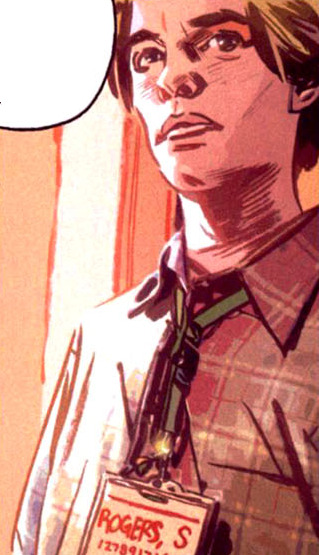
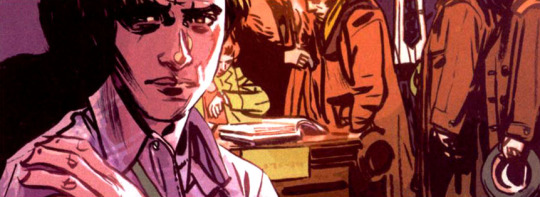
(I happen to like the art style of Bullet Points a lot, but, yeah, it's all like this. Kind of dark and smeary.)
So the Army has this giant metal weaponized suit of armor, and only a skinny 4-F guy like Steve could ever fit inside. What a coincidence! But here's the catch: he's going to need to undergo surgery to have the chestplate physically wired to his heart, via electrodes. And he's going to have to have the chestplate for the rest of his life. The chestplate is part of the control system that connects the armor to his nervous system -- yeah, yeah, Comic Book Science -- and it also acts as a dead man's switch, because the armor will self-destruct if he dies or if the Axis tries to yank him out and put their own man in.
Here's some more pictures of Steve, looking very pretty and very earnest about wanting this opportunity to serve his country:


(I know he looks almost brunet, but he’s supposed to be blond. The actual brunets basically have their hair colored black. It’s very dark art.)
And here is Steve and his Iron Man suit, before they get hitched:
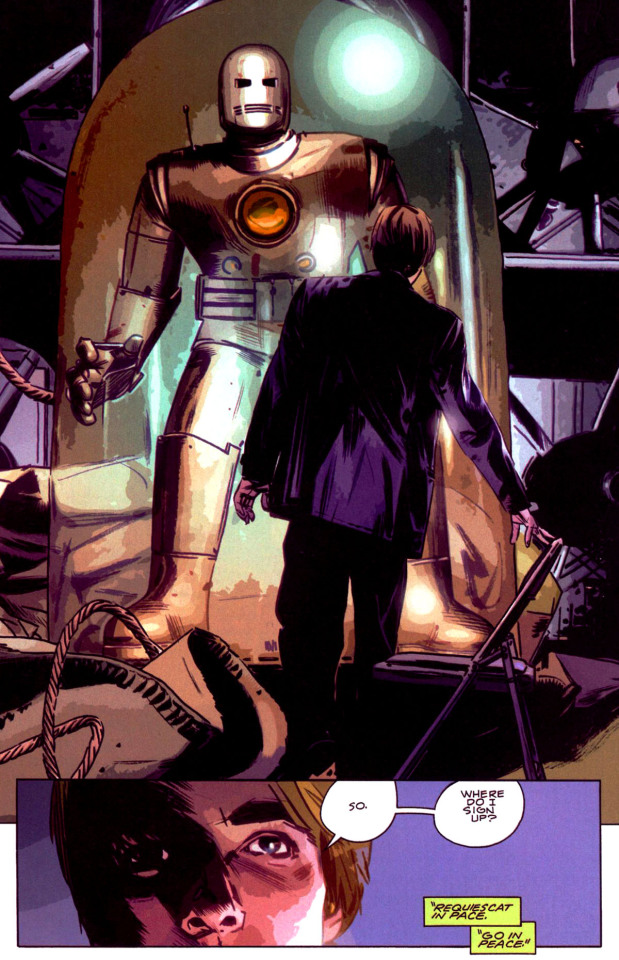
So after the surgery -- I will omit pictures of the surgery, but Steve is conscious the entire time and of course he toughs it out and says he can take it and urges them to keep going -- the Iron Man makes his debut at Guadalcanal. (Which is, like, two years after Erskine's death; I don't know what took so long.) And of course he saves the day.
A fact that is probably of interest to you h/c junkies is that fighting in the Iron Man suit causes Steve immense physical pain and exhaustion, but of course he keeps going, because he's Steve:

He doesn't get frozen. He fights all through the war. Later on we learn that the primary person responsible for keeping Steve in one piece is Reed Richards, who has taken time away from his outer space ambitions (yes, of course he still wants to go to space) to follow Steve around and patch him up:
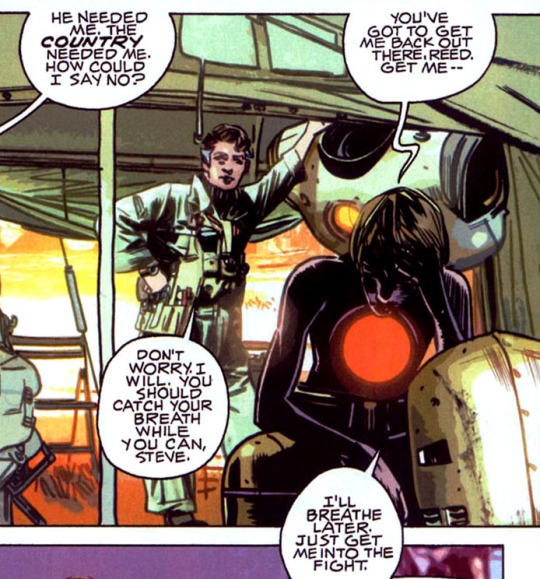
(You could probably ship Reed/Steve if you wanted. I'm just saying.)
Now I will briefly summarize some of the rest of the plot, which does intersect with the Steve plot, although honestly mostly I was just here for the Steve (and Tony) stuff and I disagree with some of the plot choices in the rest of it.
Anyway. Erskine wasn't the only death, the night before Rebirth. The MP guarding him was also gunned down -- with the same bullet -- and that man's name was Benjamin Parker. Yep. That would be Peter's Uncle Ben. Who he never gets a chance to meet. And without Uncle Ben's stabilizing influence in his life -- because, what, Aunt May doesn't count? -- he grows up into a brash, risk-taking kind of kid. The story skips ahead to when he's a teenager; we don't get precise dates, but based on the fact that the rest of modern Marvel is kicking off in these issues, and based on the design of the cars, I'm gonna date it to the early 60s. Anyway, Peter's on a field trip and his friends dare him to steal a jeep and so they do and eventually Peter ends up wandering into the gamma bomb test site and... yep, he becomes the Hulk. Yeah, okay. Fine. (Later on it turns out that Bruce Banner is in fact Spider-Man. And Strange becomes Wolverine but Wolverine is also still Wolverine. Making sense is not really a thing this AU has going for it.)
Steve, by the way, has just been given the Presidential Medal of Freedom, is a colonel, is no longer on active duty, and Reed is still trying to talk him into actually retiring because he's probably going to kill himself if he fights again. Steve tells Reed he'll be fine and that Reed should go ahead and go on his rocket mission already and stop hanging around patching him up. I mention this scene because even middle-aged Steve is still SUPER PRETTY, oh my God. Look at him:
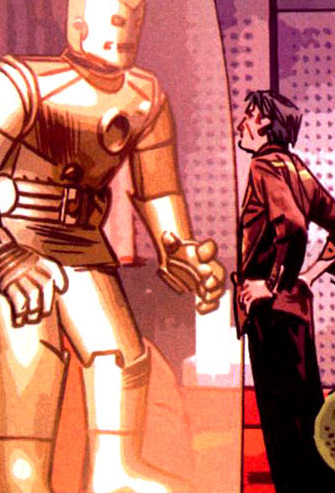
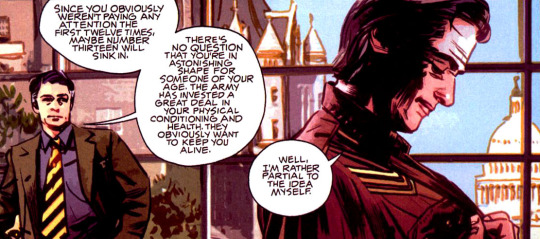


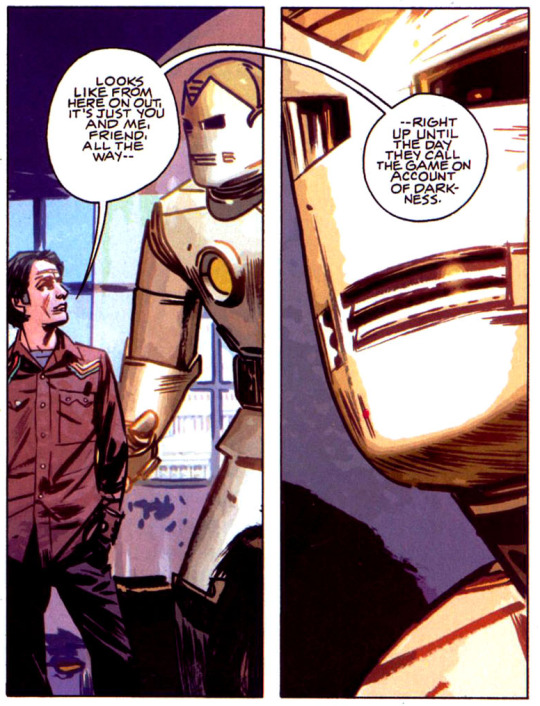
So of course when the Hulk starts rampaging through New York, the only person who has a shot at stopping him is, of course, Steve Rogers, the Iron Man. (They want to make more Iron Men, but unsurprisingly, very few people want to sign up for a lifetime physical bond to a suit of armor.) And so they pull him out of retirement, and they want him to suit up, and they want him to take down the Hulk.
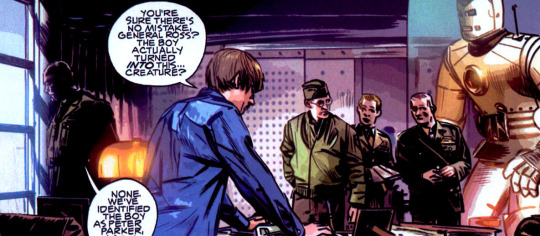
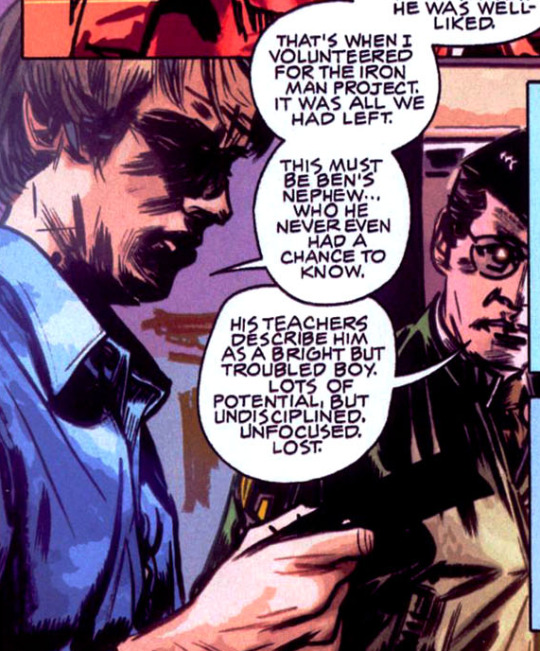

(I think you can make a case that going in, Steve knows it isn't going to go well. He expresses doubt that the new armaments they're proposing can take down the Hulk, but he doesn't want them to pull Reed off his rocket project and help him, and, okay, now I kind of think Steve knows what he's in for, as I'm rereading this. But he goes anyway. Oh, Steve.)
Steve fights the Hulk.


Steve dies.

Sure, it's tragic. But it's noble, it's pretty much exactly the death Steve would have wanted, and honestly it's the kind of death that's really, really easy to AU. *cough*
And there's still more story left!
The Fantastic Four's launch is sabotaged. Sue, Johnny, and Ben die. Reed loses an eye. At the funeral, a shadowy government figure approaches him and offers him the chance to become part of SHIELD. So Reed actually ends up the director of SHIELD, because I guess the best qualifications for that are (a) going gray at the temples and (b) having an eyepatch. Yes, that means he basically looks exactly like 616 Fury. I hope JMS thought he was hilarious when he wrote this.
And this is where Tony Stark finally enters the picture.
Here he is. He's young and pretty:

He shows up at SHIELD because he wants the contract to make more Iron Men, and, as you can see, he wants to know why there aren't more. Reed's answer is that he doesn't want anyone to suffer like Steve did:
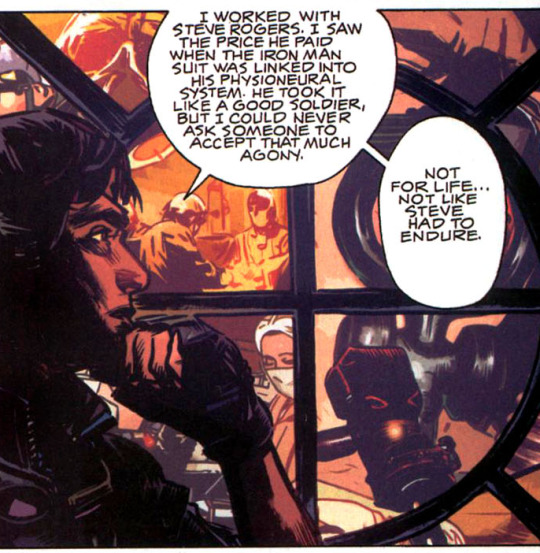
And Tony, because he's Tony, also wants to volunteer himself for the Iron Man testing:
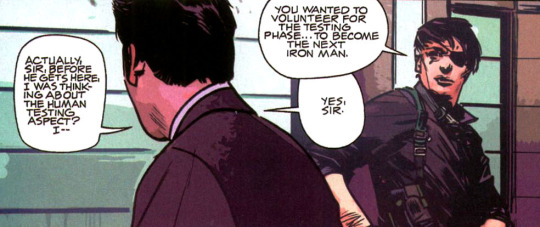
Reed says no, because Tony has a heart condition.
Reed then introduces Tony to the actual candidate for the new Iron Man... Bucky Barnes. I neglected to mention this before, but we see Steve save Bucky's life during the war. (They don't seem to personally know each other; that's as close as they get in this AU.) Bucky feels that he owes Steve his life and wants to repay the debt. Tony thinks Bucky is a lousy candidate because he's old, but Reed is kind of snappish about being in charge here and wanting to pick someone who doesn't have a weak heart (and, understandably, Reed is sad about having lost everyone he's ever cared about and doesn't want anyone else to die). So Bucky is still the SHIELD pick for Iron Man.
Spoiler alert: Bucky does not get to be Iron Man.
Reed shows Tony around the helicarrier, introduces him to Bruce Banner (Spider-Man), and then... Galactus shows up. To destroy the planet. Yeah, it's pretty sudden.
(Also, weirdly, the beginning of the last issue dates it as forty years after Erskine's death (which would then be the 1980s), but I don't think that can be right, so I'm going to ignore that and pretend it's all still in the 60s sometime because it seems weird that Reed spent at least twenty whole years building SHIELD and wants to put 60-year-old Bucky in the suit. I know that Tony complains that Bucky is too old but that's really, really too old, isn't it? So I say we can totally ignore that dating and go with the 1960s.)
Right. Galactus. Oh no! Everyone's gonna die! But, wait, who is this dapper figure, stealing the Iron Man suit?

Did you guess Tony Stark? You did? Did you guess that he's going to be Iron Man even though his heart might give out from the strain? You did? Oh, Tony.
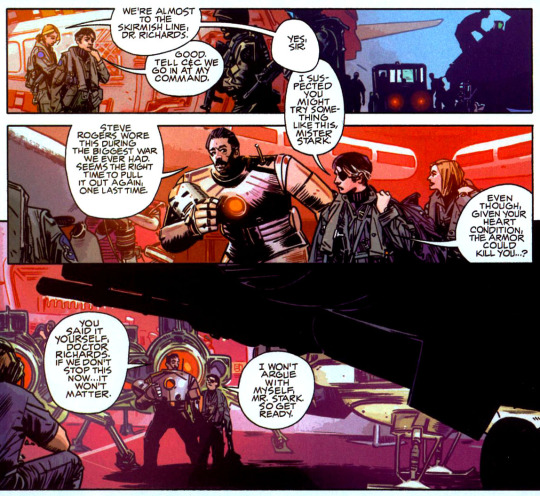

(Yeah, I'm not sure how he can wear the suit without having had the chestplate surgery either. Whatever! Comics!)
Anyway, everyone fights Galactus and the Hulk shows up and fights Galactus and dies and a lot of people die and it is noble and tragic but the Earth is saved and there is a big funeral at the end. I would just like to note that Tony survives; we see him in the background a few times. THE END.
So, obviously, I think this is perfect for Steve/Tony fandom. You can write fic where Steve doesn't die and he meets Tony! You can write fic where he and Tony knew each other at some point before the Hulk fight! Maybe Steve knew Tony when he was growing up! For the h/c fans, Steve and Tony can both have amazing chestplate-related Iron Man armor angst and pain! You can explore an all-new age difference because Steve is actually older than Tony! You can have a new and different take on Tony's hero worship of Steve, because Steve is Iron Man, because they're both Iron Man! So many story ideas!
Sure, you have to AU it! But think about, say, how many Noir Steve/Tony fics there are! And Steve doesn't even canonically exist in Marvel Noir!
The back of the Bullet Points trade paperback proclaims it to be "the Marvels of the new millennium" and while I enjoyed it a lot, as an assessment of its quality I think it's fair to say that it is definitely not the next Marvels, although from a perspective of the feels it gives me it was certainly worth it. It wasn't what you might call especially popular, meaning that I was able to find the TPB for approximately $3 new. It's on comiXology and Marvel Unlimited as well. So it is definitely easy to find and read! You all should read it! And then come write fic with me!
352 notes
·
View notes